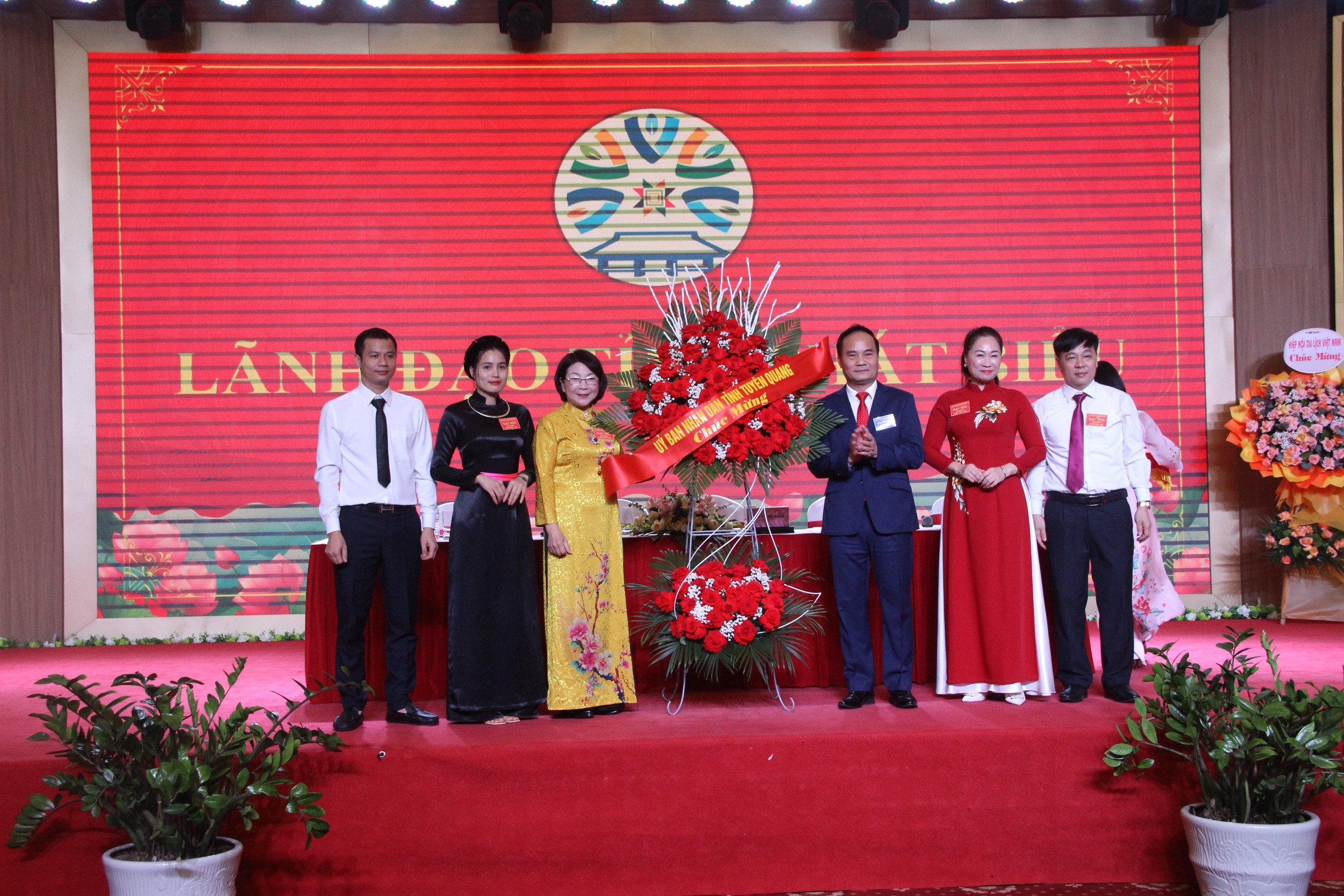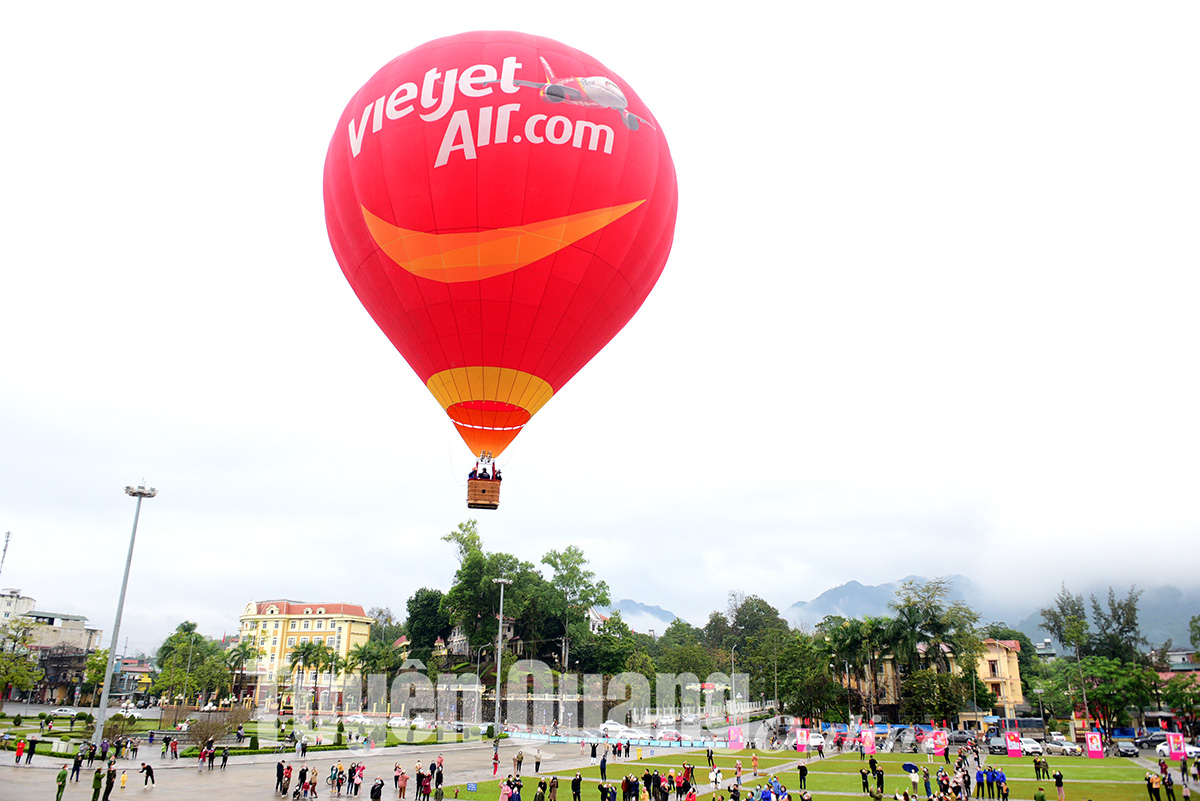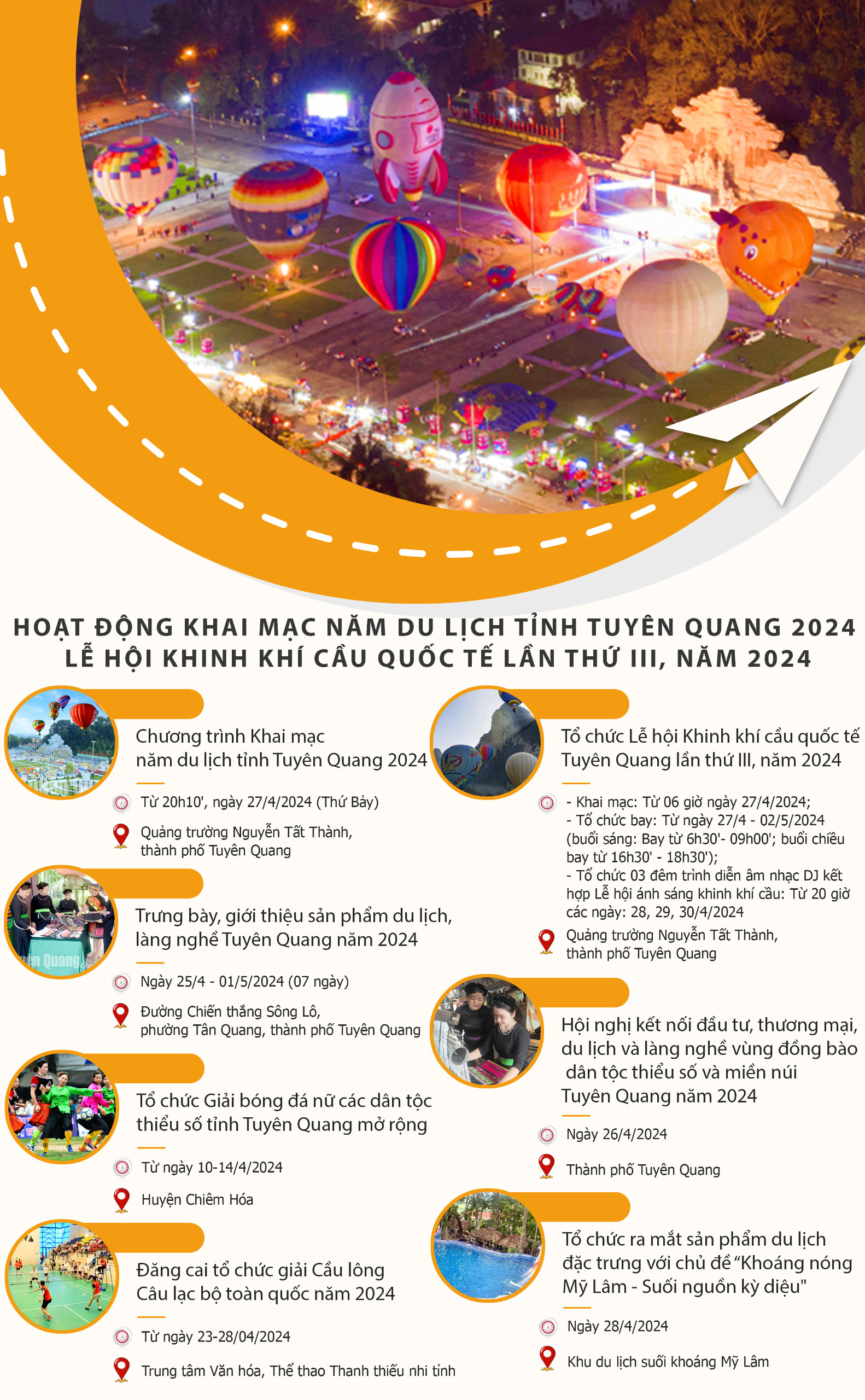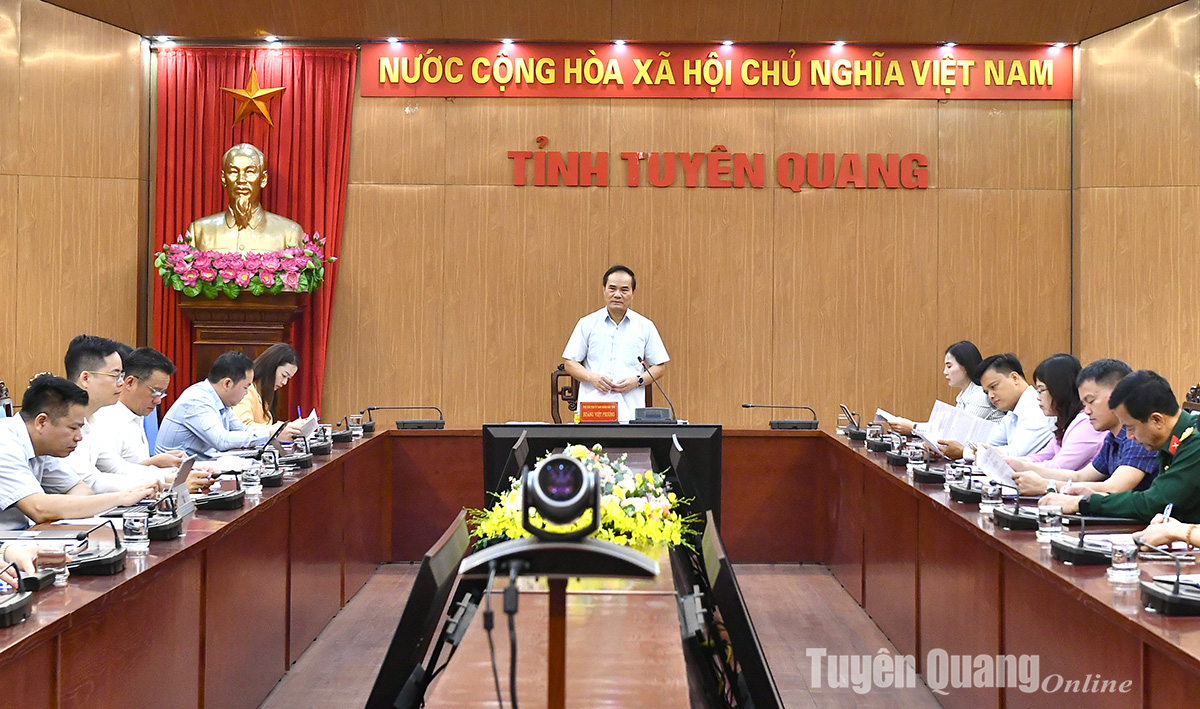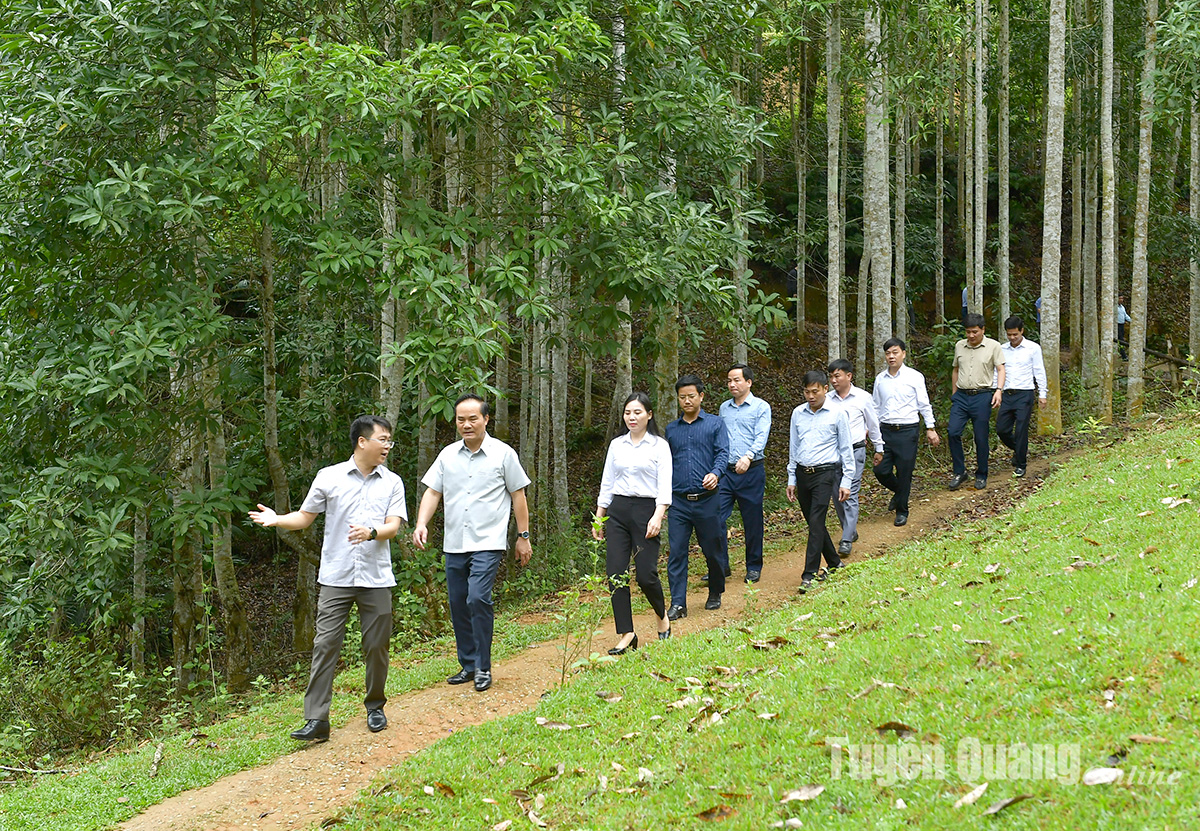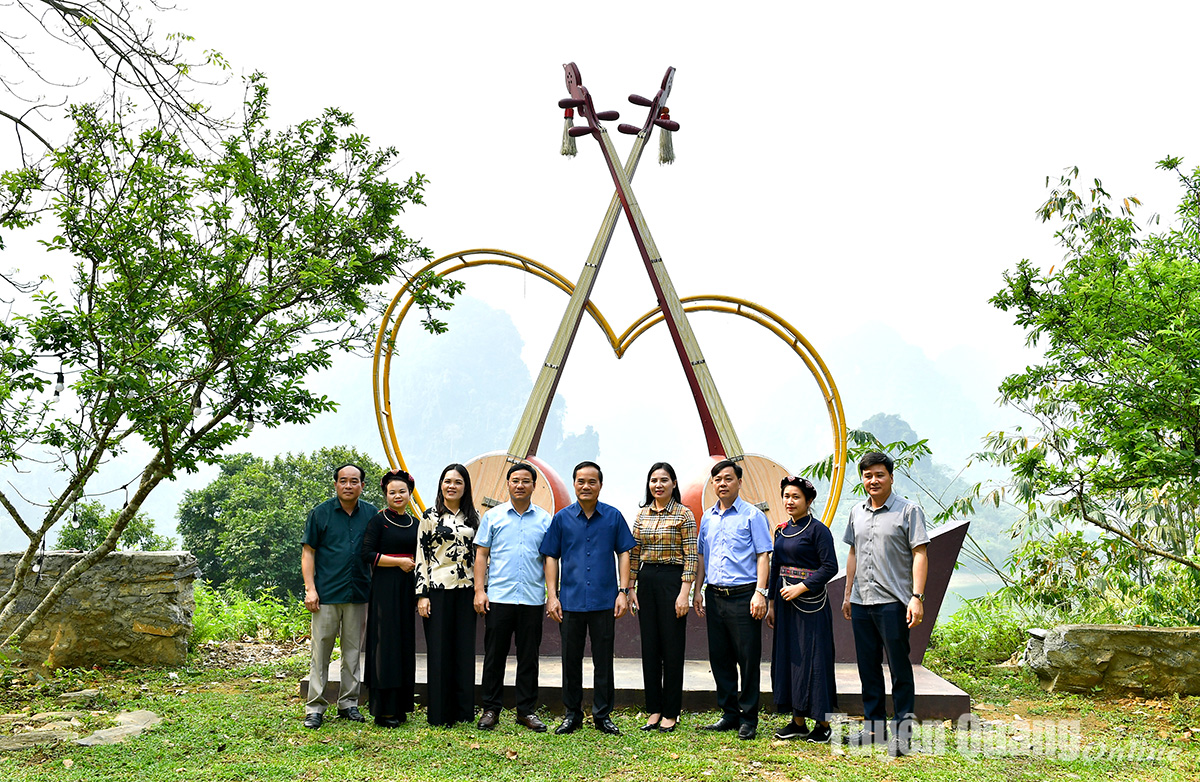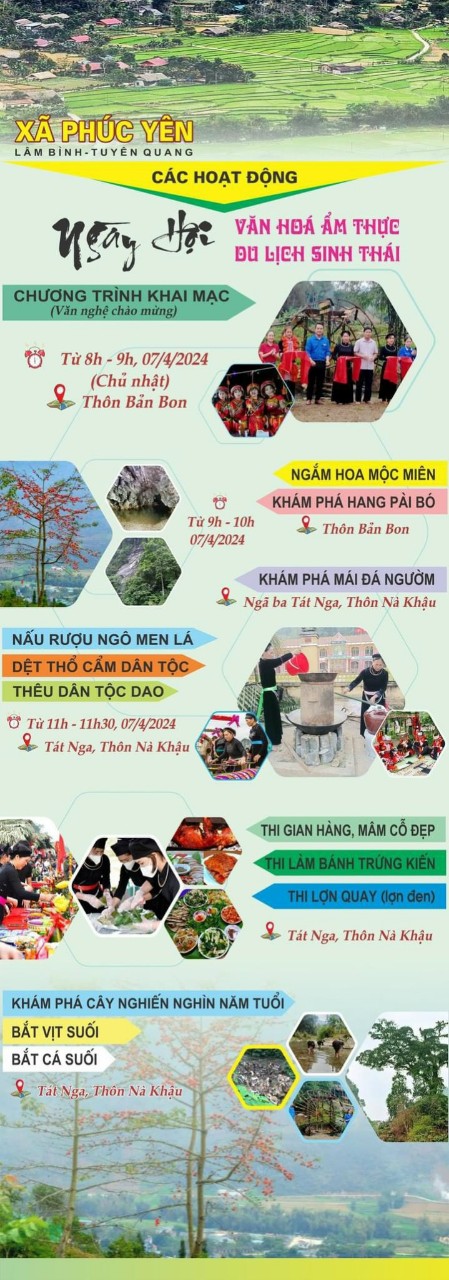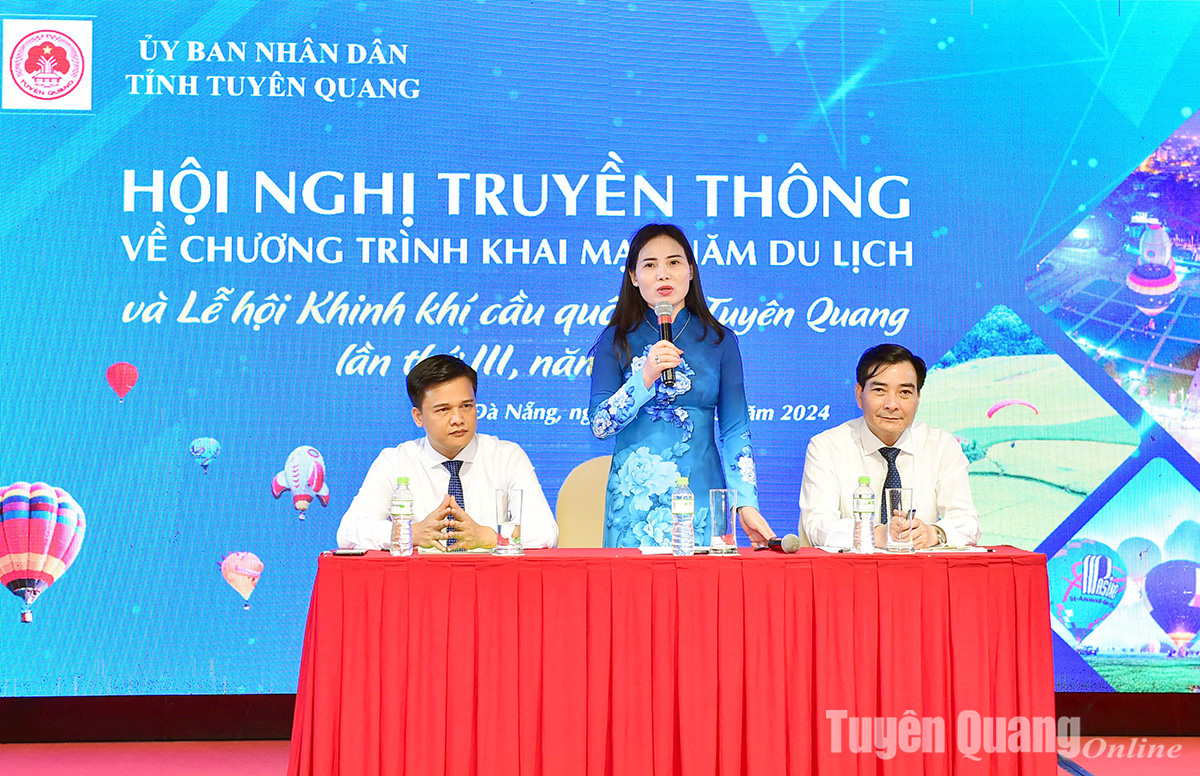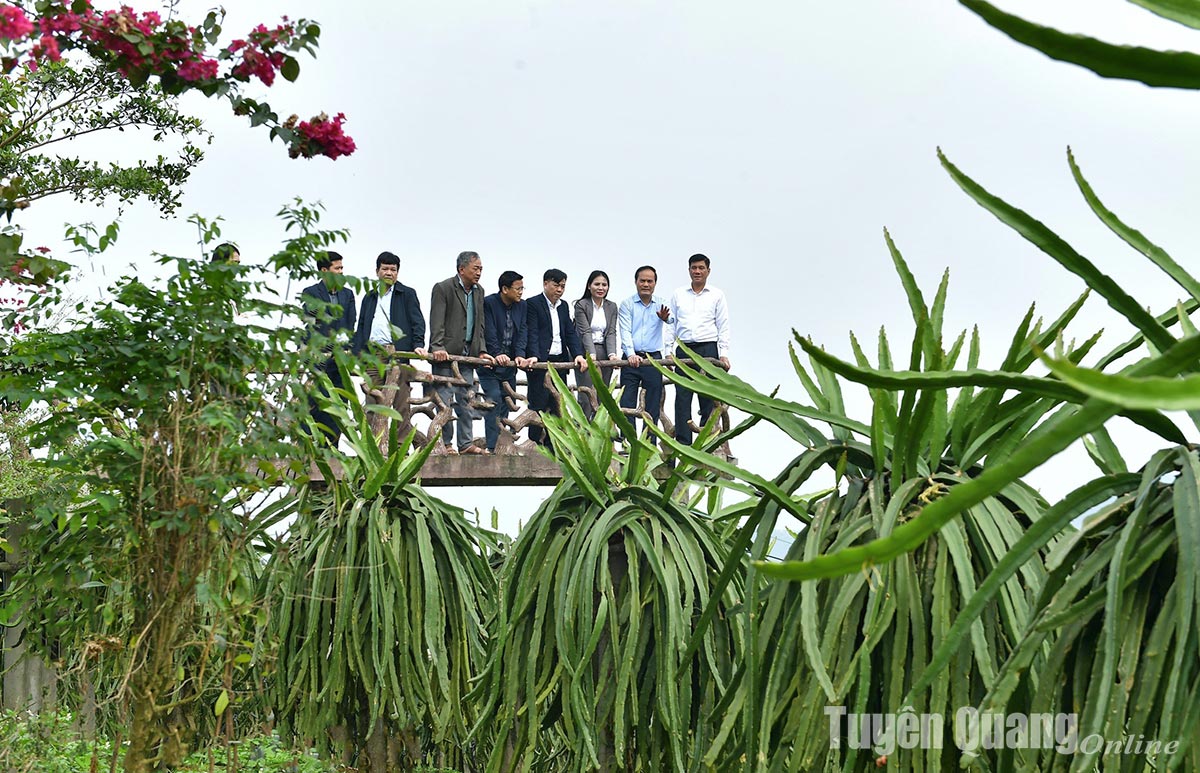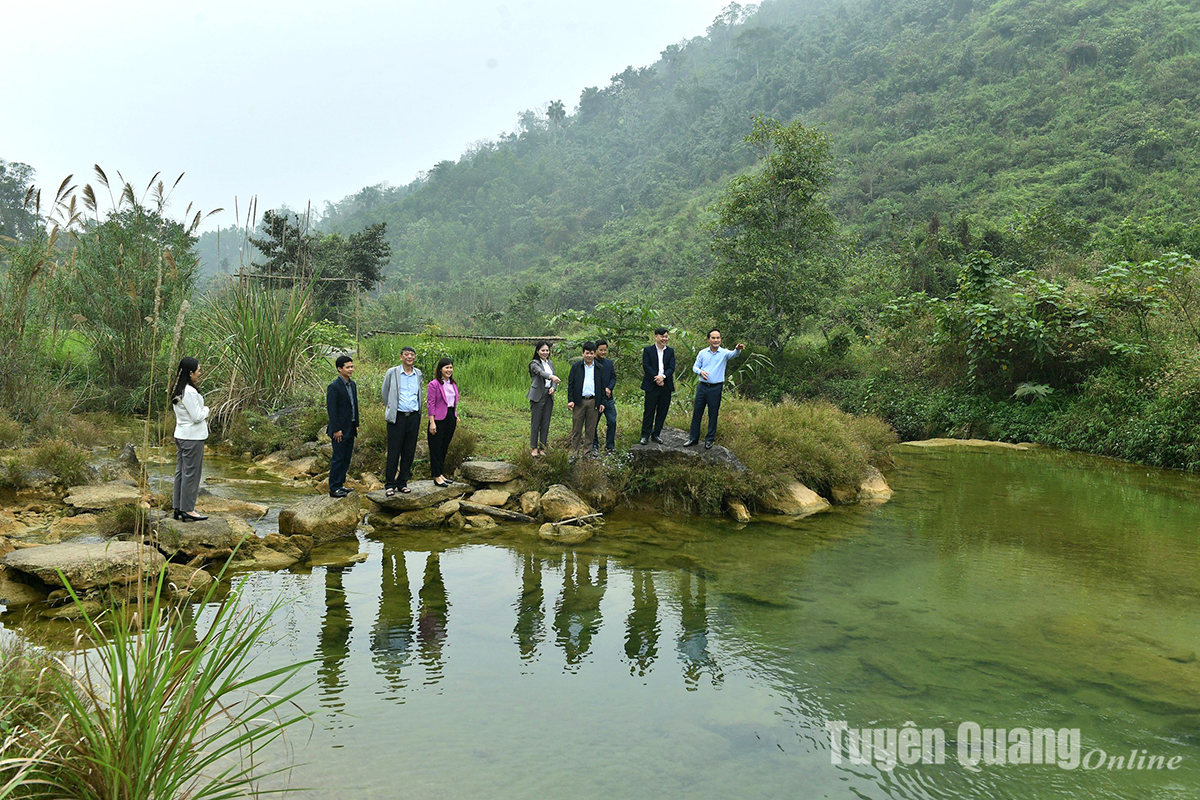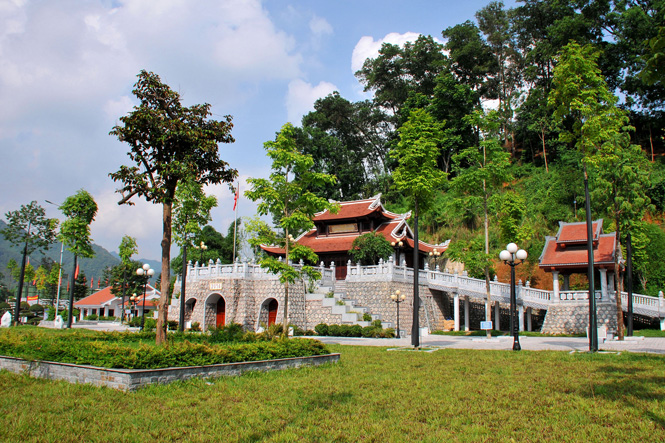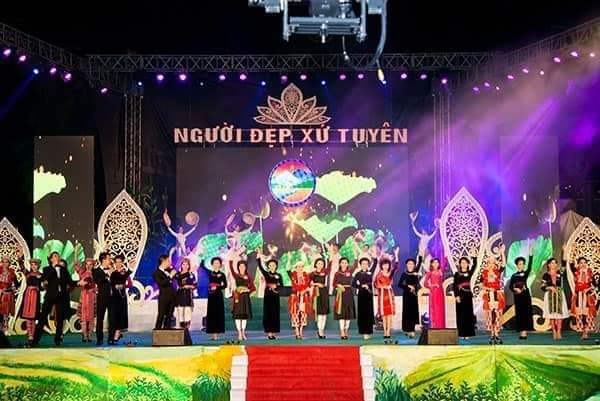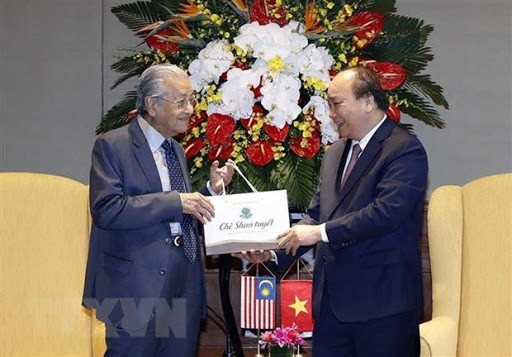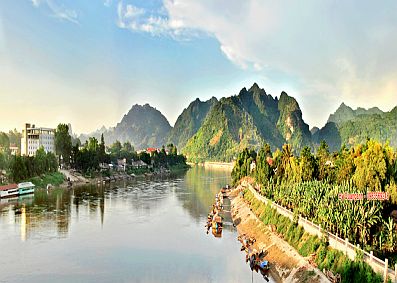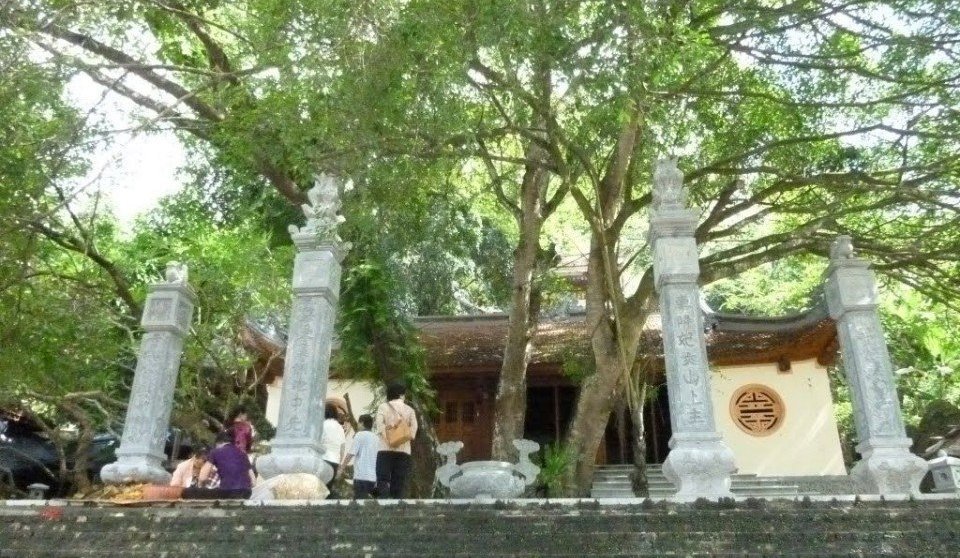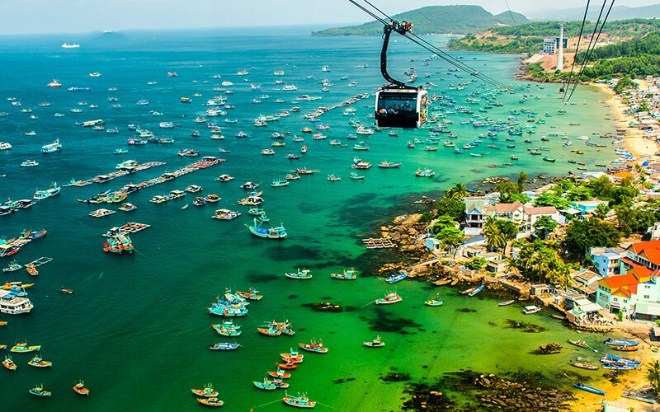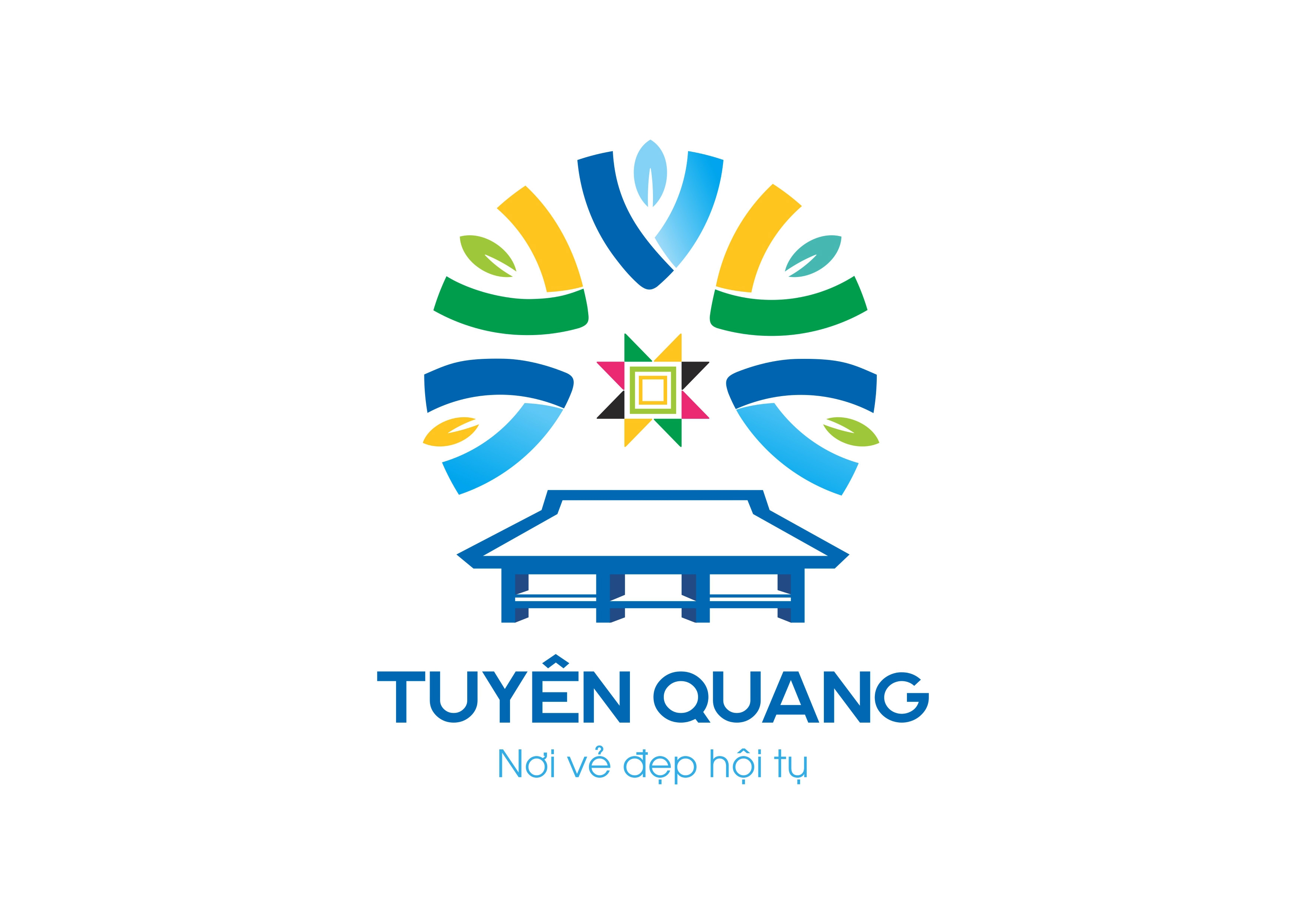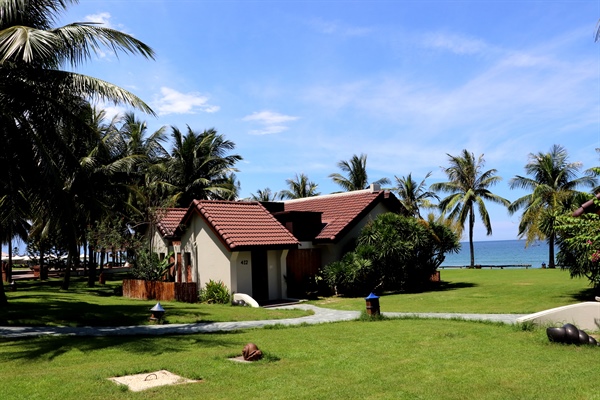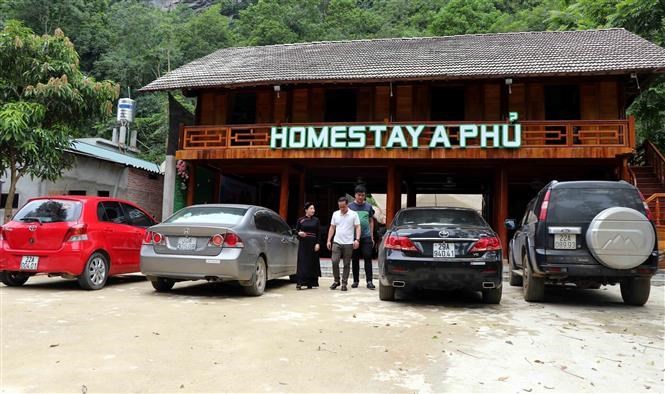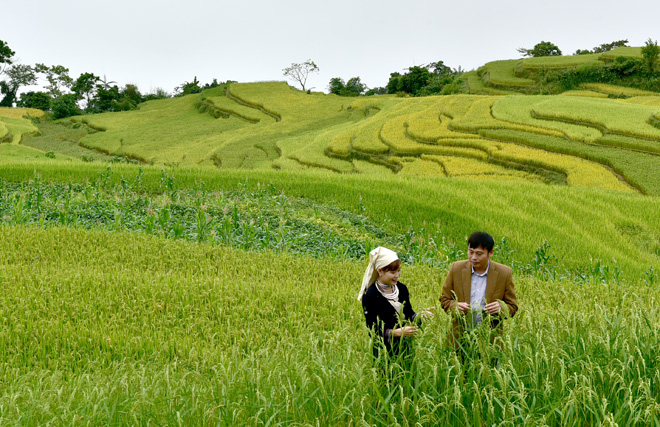X
Tuyen Quang is 140km from Hanoi capital to the north, bordering Bac Kan and Thai Nguyen provinces to the east; the West borders Yen Bai province; In the South, it borders Phu Tho and Vinh Phuc provinces; The North borders Ha Giang and Cao Bang provinces.
The topography of the province includes high mountains, accounting for about 50% of the province's total area, including the entire district of Na Hang, Lam Binh, and 06 highland communes of Chiem Hoa district (Phuc Son, Minh Quang, Phu Binh, Binh Phu, Yen Lap, etc.) Kien Dai) and 02 highland communes of Ham Yen district (Phu Luu, Yen Lam); The lowland and midland areas account for about 50% of the province's area, including the remaining communes of the 02 districts of Chiem Hoa and Ham Yen and the districts of Yen Son, Son Duong and Tuyen Quang city. The highest point is Cham Chu mountain (Ham Yen) with an altitude of 1,587m above sea level.
Important roads in the province are National Highway 2 from Vinh Phuc, Phu Tho, Tuyen Quang and Ha Giang, the section through the province is 90km long; national highway 37 from Thai Nguyen through Son Duong and Yen Son districts to Yen Bai; national highway 2C from Vinh Phuc to Tuyen Quang to the center of Na Hang district; Highway 279 from Bac Kan through Tuyen Quang to Ha Giang. The river system of the province includes 500 large and small rivers flowing through. The main rivers are: Lo River, Gam River, Nang River (Nang River) and Pho Day River.
* Climate
- Annual average temperature 220C - 240C
- The average highest temperature is 330C - 350C.
- The lowest average temperature is from 120C - 130C.
- The average annual rainfall is from 1,500 to 1,700 mm.
Characterized by a tropical monsoon climate, influenced by the continental climate of North Asia China has 2 distinct seasons: a cold - dry winter and a hot, humid summer with lots of rain; concentrated rainstorms from May to August; The coldest months are November and December (lunar calendar).
Attractive tourist attractions worth experiencing when coming to Tuyen Quang:
TAN TRAO HISTORY AREA - SON DUONG
Na Lua Shack:

It was the place where Uncle Ho lived and worked from the end of May to the end of August 1945 to prepare for the General Uprising. The shack is built of bamboo in the style of a stilt house. On June 4, 1945, at this place, Uncle Ho convened a cadre conference to prepare for the establishment of the "Liberation Zone, Liberation Army", towards the National Congress and the General Uprising. Currently, the shack is still preserved and is an attractive tourist destination for tourists to visit.
At Na Nua shack, Uncle Ho instructed: The liberated area included 6 provinces (Cao Bang - Bac Kan - Lang Son - Ha Giang - Tuyen Quang - Thai Nguyen) and the terrain was interconnected, so the base area was established. , named the Liberation Zone; the armed forces, after being reunified, took the common name of Liberation Army; convene a meeting of cadres of the whole area to unify the leadership and deploy the work. Obeying Uncle Ho's instructions, on 4-6-1945, Viet Minh Headquarters convened a meeting of cadres of the whole area. The Conference decided to establish the Liberation Zone, unify the armed forces into the Liberation Army; proposed 10 major policies of the Viet Minh...Tan Trao was chosen as the "Capital of the Liberation Zone", becoming the heart of the Vietnamese revolution. From the small shack of Na Naa - from Tan Trao, all directives and resolutions on the Party's motto, lines and strategies to promote the General Uprising were transmitted throughout the country.
Also here, Uncle Ho was very interested in cadres work. According to his instructions, on June 25, 1945, the Military School of the Resistance against the Japanese opened the first course, at Khuoi Drama, Tan Trao commune. The leader selects a number of students who know English or French from the Military School of the Resistance to the Japanese to participate in the reporting class (training radio staff)...
At the end of July 1945, due to extremely arduous and inadequate working conditions, with meager meals of only bamboo shoots dipped in sesame salt, rice and green tea, along with Uncle Uncle's health declined much in During the time he was imprisoned in the imperial prison, he was seriously ill, had a constant fever, was awake and in a coma. Everyone was very worried about Uncle, some people went to the forest to look for medicinal leaves to make water for Uncle, some people went to Pho Day river, but their fathers brought them back to cut blood into small pieces for Uncle to drink, praying that Uncle would get well soon.
Comrade Vo Nguyen Giap, who was living and working at that time at Mr. Hoang Trung Dan's family, in Tan Lap village, daily went to Na Naa shack to report on the work situation to Uncle Ho. One day, when he went to report his work, seeing that Uncle Ho was very weak, comrade Vo Nguyen Giap asked to stay with him. That night, after waking up from a fever, Uncle Ho said to comrade Vo Nguyen Giap: "Now the favorable time has come, no matter how much you sacrifice, even if you have to burn down the entire Truong Son mountain range, you must resolutely win the independence. create". At other times, Uncle Ho said: "Always pay attention to building a cell, fostering cadres, party members and loyal elements. In guerrilla warfare, when the movement rises, we have to do our best to develop, both develop and pay attention to building a solid base, so that we can have a foothold in difficult times." The words of advice and affirmation of Uncle Ho's will, determination and heart for national independence when the time is right.

The next day, Comrade Vo Nguyen Giap wrote an express letter informing Uncle Ho's health to the Central comrades and looking for someone to treat him. Thanks to the advice of the people, an old Tay healer came to treat Uncle Ho. After taking the pulse, the old man went to the forest and brought back a tuber, burned it and mixed it with a thin porridge to invite Uncle to drink. Drinking a few times like that, he gradually got better and got up to continue working.
The situation was extremely urgent when the Red Army of the Soviet Union smashed Japan's Kwantung army, Uncle Ho proposed the Central Committee to urgently organize a National Party Conference "The meeting should be held immediately and the conference should not be prolonged. We must take advantage of every moment. The situation will change quickly, the opportunity cannot be missed.” From August 13 to 15, 1945, the Party's National Conference of Cadres was convened at Tan Trao, including more than 30 delegates from the Tonkin, Trung Ky, and Cochinchina Party Committees to discuss and decide on the following issues: matters of great importance to the fate of the country. The conference was held at a shack about 20 meters northwest of Na Nua shack where Uncle Ho lived. This is a 2-room shack, made of temporary wood, cork, thatched with palm leaves, surrounded by empty space, there are no tables and chairs in the shack. The delegates to the meeting used palm leaves to spread on the ground and small logs to sit on. The conference decided to launch a nationwide uprising to seize power throughout the country; established the National Uprising Committee... At 23 o'clock on August 13, 1945, the National Uprising Committee issued the Military Order No. I, calling for: "O people and people of the whole country!... Now the General Uprising! came! A once-in-a-lifetime opportunity for the Vietnamese army and people to rise up to gain the independence of the country…”.
On August 15, 1945, receiving news that the Japanese fascists officially surrendered to the Allies unconditionally, Uncle Ho suggested that the National Party Conference end early so that the delegates could still return to their respective localities to lead. revolutionary. On August 16 and 17, Uncle Ho attended the National Congress at Tan Trao communal house. The Congress warmly endorsed the policy of the General Uprising as decided by the Party's National Conference. The Congress elected the Committee for National Liberation of Vietnam (ie the Provisional Government), chaired by leader Ho Chi Minh, approved ten major policies of the Viet Minh Front, stipulating the national flag and anthem of the Socialist Republic of Vietnam. After the National Congress, on August 18, 1945, Uncle Ho wrote a letter calling for a general uprising, to the nation and compatriots. In this letter, he signed Nguyen Ai Quoc for the last time.
On August 22, 1945, although still very tired, Uncle Ho decided to leave Na Naa shack and return to Hanoi. From a small and simple shack - Na Naa shack, in the forest of Na Naa, with the right judgments, timely and bold decisions about revolutionary opportunities, Uncle Ho pointed the way for the whole nation to create made a turning point of great historical significance: The Vietnamese people ended the days of miserable slavery, entered the era of independence, freedom and socialism.
In order to preserve the special value of the relic, in 1972, the relic of Na Nua shack (Na Lua shack) was restored at the site of the old shack. In 2009, Na Naa shack continued to be renovated; at the same time, restore the system of relics: the Party's National Conference Hall of cadres (20m to the northwest of Uncle Ho's shack), the guard lane (30m to the west of Uncle's shack), the radio shack. 30m from Uncle's shack to the south), Allied shack (about 40m from Uncle's shack to the north). Lan Na Naa, is one of 138 relics and clusters of relics in Tan Trao historical relic area ranked as a special national relic by the Prime Minister, on May 10, 2012.
People's Public Security Historic Site
The People's Public Security Historic Site has witnessed many significant historical events marking the mature steps of the People's Public Security force. The entire house and working house of the Public Security Bureau are located on two large hills, commonly called hill A and hill B. These two hills are adjacent to each other, under which is Lung Co field (with Lung Co airport). wide. Behind the two hills A and B is Temple mountain surrounded. Around the Police Department, there is a trench transportation system connecting the two hills A and B and the defense and combat divisions when there is a war. On August 14, 1999, the Ministry of Public Security commenced construction, restoration and embellishment of the historical relic site of the Vietnam Public Security Bureau. The highlight of the relic site is the stone monument complex, with an area of nearly 3,000m2, with the center being the Monument "For the security of the Fatherland", made of the largest monolithic granite in our country today. 21.6m, 4.5m in diameter, 420 tons in weight. The image of a soldier raising a dove in his hand represents the peaceful aspiration of the Vietnamese people. At this relic site, more than 2,000 artifacts are kept - an invaluable archive of documents of the People's Public Security force through the periods. Bong Cave

It was the residence and working place of Uncle Ho during the resistance war against the French. The cave is located halfway up Bong mountain, at the foot of the mountain is the meandering Pho Day river embracing the right side of the mountain range. It was here that Uncle Ho directed the 1950 Border campaign and the 2nd National Party Congress in 1951 Bong Cave is a discreet place, convenient for communication and direction, because it is located in the center of the safe zone, near the Office of the President - Prime Minister in Thac Dang - Lap Binh, Binh Yen commune, across the river. Deputy Day. In front of the cave, the guards built a small shack for Uncle Ho to live and work in. The stilt house style, the beams are pillowed on the cliffs, roofed with palm leaves, surrounded by double bamboo woven around. The shack is located under the forest canopy, ensuring safety and secrecy. From the top of the shack, a large area can be observed below. There is a well of cool water here, every day Uncle goes down to get water for daily life. Despite being busy with hundreds of thousands of jobs, Uncle still spends time increasing production, playing with children, practicing sports, and fishing. Every time he went to Pho Day river to bathe, when he returned, Uncle brought small stones and arranged them on the steps up and down the cave so that it wouldn't rain. During his time in Hang Bong, Uncle Ho attended and chaired many important meetings of the Central Committee of the Party and Government, wrote newspapers, wrote poems, wrote letters to visit and encourage cadres and soldiers in the front. children, people in areas temporarily occupied by the enemy... Many important decisions from Bong cave changed the battlefield situation; diplomatic relations were built and consolidated, bringing Vietnam's political position to a new height; Financial and monetary work was focused to create strength for the resistance economy. Also from Bong Cave, Uncle Ho went on a business trip to the Soviet Union and China; to the front to direct the campaign. Here, Uncle Ho signed the Ordinance on the establishment of the National Bank of Vietnam; the decree on tax on agricultural areas; announced "Eight Commandments of the Government of the Democratic Republic of Vietnam"... While living and working in Hang Bong, Uncle Ho paid special attention to criticism and self-criticism. Three times he wrote the article "Self-criticism and criticism", "Need to clean up the disease of bureaucracy and command", published in Nhan Dan newspaper. At Bong cave in August 1951, Uncle Ho sent a letter of thanks to Mrs. Pham Thi Duoc - a soldier's mother in Tuyen Quang, for giving him a 100 kg of rice; Vu Dinh Doc, an agent of the National Salvation Newspaper in Binh Ca - Tuyen Quang, gave him 2 bonds worth 100 kg of rice for him to be an emulation prize.
Tan Trao Communal House

Is a communal house worshiping Thanh Hoang and the river and mountain gods of Tan Lap village. The communal house was built in the year of the Pig (1923) in the style of a house on stilts, wooden columns with 3 compartments and 2 wings, thatched roof with palm leaves. Under this roof, on August 16, 1945, delegates from all over the country returned home. National Congress meeting.
Here, the delegates approved the Party's policy of conducting a General Uprising, approved the Uprising Order and 10 major policies of the Viet Minh, stipulating that the national flag is the red flag with a yellow star, the national anthem is the song Tien Quan. and appointed the Committee for National Liberation of Vietnam ie the Provisional Government led by comrade Ho Chi Minh as Chairman. On the morning of August 17, 1945, on behalf of the National Committee for the Liberation of Vietnam, Uncle Ho recited a sacred oath at the National Opening Ceremony here.
Tan Trao Banyan Tree

Under the Tan Trao banyan tree, on the afternoon of August 16, 1945, General Vo Nguyen Giap read the Military Order No. 1, and right after that, the Vietnamese Liberation Army held a ceremony to move towards the liberation of Hanoi capital before the invasion. witnessed by all ethnic groups of Viet Bac and 60 delegates nationwide. Since then, Tan Trao banyan tree has become a revolutionary symbol of the capital of Tuyen Quang liberated area
Tan Trao Museum

Exhibition House Tan Trao Museum (Tuyen Quang) currently holds 128 artifacts, 112 paper documents, photo documents and more than a thousand scientific documents. Most of them are artifacts and documents about Uncle Ho, the Party Central Committee, the Government during the August Revolution in 1945 and during the years of resistance against the French colonialists.
Dinh Hong Thai

The communal house is located in Kim Battle village (now Ca village), Tan Trao commune, Son Duong district. The communal house was built in 1919, with pure wood architecture, palm leaf roof, 3 compartments and 2 wings, the shape of a mountain house on stilts.
Hong Thai communal house as well as the communal house of Vietnam with the religious function of worshiping the village Thanh Hoang, the river god, the mountain god and the surrounding gods. In addition, the communal house also worships a human god, Ngoc Dung Princess. Moreover, the communal house is also a place for cultural activities and meetings of the village.
Every year the villagers organize many worshiping ceremonies at the communal house, the holidays are based on the season of the year. The biggest holiday is on the 3rd day of the first lunar month, on this holiday, the people organize the procession of Princess Ngoc Dung; The festival part has many interesting games such as singing then, singing cai, folk games, etc.
In addition to the cultural and religious value, the communal house also has historical value. Because this is the first stop of leader Nguyen Ai Quoc when people from Pac Bo, Cao Bang came to the revolutionary base of Tan Trao on May 21, 1945.
TOURIST POINTS IN QUEEN QUANG CITY
Tuyen Quang Provincial Museum

Tuyen Quang Museum is not only a place to store and display tangible and intangible cultural heritages; historical and cultural relics, scenic spots, but also perform the function of scientific research reflecting the development process in all aspects of the province. From the perspective of historical tourism, cultural tourism, the project is also a destination of Tuyen Quang people in particular, the whole country in general and international tourists. In particular, the interior and garden display sections are designed according to the detailed display outline content, eliminating the minutiae and duplication in order to create attractiveness for the public from external appearance to historical artifacts. history and culture.
The museum has a display area of 1,600 m2 is divided into 4 parts: the reception space and 3 large thematic exhibition space according to the themes.
The ceremony space starts from the central exhibition space of the museum, where the tour begins. The first impressive image is a wooden relief with an area of 100 m2 with Na Naa shack, Tan Trao banyan tree. , Tan Lap village - The image of "Capital of the Liberation Area" combines with the display of beautiful landscape photos, photos of the history and culture of Tuyen Quang land.
Theme 1: is organized into a subheading on natural conditions - economic potentials of Tuyen Quang province and a sub-title on cultural characteristics of ethnic groups in Tuyen Quang. Theme 2: displaying artifacts and groups of artifacts about Tuyen Quang in prehistoric and early history; history of building and defending the homeland.
Theme 3: Tuyen Quang - Capital of the Liberation Zone - Capital of the Resistance and the road to building socialism.
With the display of artifacts, unique art architecture, beautiful space, the museum has attracted a large number of tourists to visit and historical researchers to learn. In particular, the Museum is displaying fossil remains of primitive people about 12,000 years ago, which are still relatively intact. The remains were excavated at Phia Vai cave (Na Hang). The special thing about this remains is the unique burial method with 2 sea snails placed in two eye sockets. Along with the original human remains are a kettle with a human head and a bird body in the Ly Dynasty (XI, XII centuries) and 2 Hegen bronze drums of type 1.
With the diversity, richness and uniqueness of artifacts and groups of objects, Tuyen Quang Museum is considered to have a large scale and number of artifacts in the system of museums in our country. This is also an attractive point, attracting viewers.
Simultaneously with the display activities, Tuyen Quang Provincial Museum also inventoryed 426 intangible cultural heritages and made a dossier of 7 heritages included in the list of National Intangible Cultural Heritage; develop a political outline, an exhibition outline, a plan to display the provincial museum and a number of projects to collect, preserve and restore documents and artifacts... 30 sites, organize the implementation of the project to restore the relic of Bao Ninh Sung Phuc Pagoda and step by step perfect the facilities, display artifacts to serve the people and tourists near and far to visit, admire, contribute to preserving, preserving and promoting the valuable cultural heritage values of the people of the ethnic groups in Tuyen Quang province. Currently, Tuyen Quang Museum is keeping records and managing 376 out of a total of nearly 560 relics in Tuyen Quang area, including 93 national relics and 189 provincial relics. Especially, in the past 30 years, Tuyen Quang Museum has collected, kept and preserved 21,500 documents and artifacts, including 14,000 artifacts; 11 collections and artifacts have been built, 90% of documents and artifacts are scientifically inventoryed; to request the Prime Minister to recognize an artifact as a national treasure; prepare a dossier for recognition of 1 Vietnamese heritage tree.
After 30 years of construction and development, Tuyen Quang Provincial Museum has made great efforts in preserving cultural heritages in the province. Recently, the Department of Culture, Sports and Tourism of Tuyen Quang province announced and awarded the Decision of the Provincial People's Committee to rank the Museum Grade II for the Museum of Tuyen Quang Province.
Nguyen Tat Thanh Square

Nguyen Tat Thanh Square was built in the center of Tuyen Quang city, Tuyen Quang province. The project was inaugurated on May 19, 2015, this is a very important work for the people of Tuyen Quang, a place to educate the young generation about the spirit of solidarity and pride of the people of Tuyen Quang. people of Tuyen Quang province for the merits of President Ho Chi Minh. Since its inauguration, Nguyen Tat Thanh Square has become the highlight of the city center with a safe and airy space, a place for healthy entertainment and relaxation of all classes of people in Tuyen Quang.
Every year, Nguyen Tat Thanh Square attracts over 100,000 turns of people to visit, offer incense, newspaper and participate in fun and entertainment activities; especially attracting a large number of visitors on holidays, Tet or major political, cultural and social events of the province and country.
Every year in the 8th lunar month, Nguyen Tat Thanh Square is honored to be chosen as the venue for the Mid-Autumn Festival - one of the program contents of Thanh Tuyen Festival. This festival has been established by a Guinness record: "The festival has many unique and largest models of Mid-Autumn Festival lights in Vietnam", "The largest Mid-Autumn Festival tray in Vietnam", "The largest pair of lanterns in Vietnam" . This is a unique festival, a unique cultural beauty of Tuyen Quang homeland.
In recent years, many schools in Tuyen Quang province, especially Kindergartens (Phan Thiet, Tan Trao, Ỷ La, Trang Da, Luong Vuong ...), in addition to classroom learning, the school has organized organize extracurricular activities at Nguyen Tat Thanh Square for students. These extracurricular activities not only help children learn and have fun, but through them they also get practical experience, practice life skills, and traditional education “Drink water, remember the source”, " When eating fruit, remember who planted the tree."
Not only is it a place to organize major political, cultural and social activities, Nguyen Tat Thanh Square is also a place to organize fun service activities for children. This game service is held mainly in the time frame (17 – 22 hours daily). The types of games are very rich and diverse such as: electric cars, electric motorbikes, sand houses, painting statues, fishing ... should attract a large number of people from all walks of life to participate, especially young children. adolescents, children.
Mac Dynasty citadel

The Mac citadel (Tuyen Quang citadel) is located on the territory of Group 8, Tan Quang ward, Tuyen Quang city. The citadel was built in 1552, during the Mac Dynasty and repaired in the early Nguyen Dynasty (nineteenth century). The citadel has an important military position, located on the banks of the Lo River and is located on the convenient waterway traffic axis, once associated with many important historical events of Tuyen Quang province. Tuyen Quang ancient citadel is the place to witness many important historical events of the revolutionary countryside of Tuyen Quang, from the heroic fight of the Kinh, Tay, Dao and Cao Lan ethnic groups against the French colonialists in 1884, In the days of the historic August 1945 uprising, the Japanese fascists had to surrender and completely liberated Tuyen Quang town. During the resistance war against the French colonialists, Tuyen Quang ancient citadel twice witnessed the defeat of the French army in 1947 and 1949. On March 20, 1961, for the first time since the Government of the Democratic Republic of Vietnam moved to Hanoi, officials, soldiers, and ethnic people in Tuyen Quang province were honored to welcome Uncle Ho back to visit. revolutionary homeland Tuyen Quang. He had a talk with the entire people at the stadium (now Nguyen Tat Thanh Square) north of Tho Son mountain right in the ancient citadel. Tuyen Quang ancient citadel was still quite intact until the end of the twentieth century, during the construction and development of Tuyen Quang city, some roads of the city ran through the position of the ancient citadel, so now Tuyen Quang ancient citadel was destroyed. divided, many sections of the wall no longer exist. There are two gates left in the north and west. The only remaining section of the wall is located on the corner of Binh Thuan and Gate Lap streets, more than 140m long. So far, Tuyen Quang Citadel is a symbol of the history of Tuyen Quang land and has been recognized as a national historical - cultural relic.
An Vinh Pagoda

An Vinh Pagoda is located on a hill in Group 7 of Hung Thanh Ward (Tuyen Quang City), in an area of 1,000m2. The pagoda is called "An Vinh Thien Tu", built around the beginning of the 18th century. Tam Quan pagoda with three gates and 4 pillars, with a unicorn sitting on it, carving stations of bamboo, chrysanthemum, apricot ... Currently, the Upper Palace of the temple still preserves 13 ancient statues, two bronze bells and a Khanh. In particular, the pagoda has two stone inscriptions carved in Vinh Thinh year (1720) of the reign of King Le Du Tong and a stone stele carved in 1720. The pagoda has a worship tower: Duc Tien Su, Thich Tam Quang, and Thich Thanh Tung.
Cave temple

Hang Pagoda Festival (also known as Huong Nghiem Pagoda) in An Khang Commune (Tuyen Quang City) is held on January 8 every year. This is an ancient temple built in the 16th century, built in 1537 under the reign of Mac Dang Doanh in a rocky cave. The pagoda also preserves the ancient stela carved on the cliff, two bronze statues of Bodhisattvas, a reading stand, incense, and tray of the Nguyen dynasty. The pagoda is located in Huong Nghiem mountain, in Phuc Loc village, in the relic complex with Bau Citadel, Binh Ca wharf. This is a place with charming natural scenery, a land with a rich culture with the place Truong Thi - the place where the exams of the feudal dynasties were held. From the beginning of Phuc Loc village to the end of Tan Thanh village of An Khang commune, there is a mountain range bearing the shape of a winding dragon, Huong Nghiem mountain is likened to a dragon's head. This is also the place to hide and assemble the first two aircraft of the Vietnamese Air Force before moving to Soi True airport, Vinh Quang commune (Chiem Hoa). Hang Pagoda has been recognized as a provincial historical relic. Over time, Huong Nghiem Pagoda no longer preserves historical vestiges of the resistance wars, but only preserves valuable artifacts such as a system of worshiping statues, incense altars, etc.
In front of Huong Nghiem pagoda, there is an ancient stele carved on the cliff on February 27, the 8th Dai Chinh year of the reign of Thai Tong Mac Dang Doanh (1537). It has a height of 1.25m and a width of 1m. The stele consists of two parts: the forehead and the body of the stele, on the forehead is carved with a bi-dragon adoring the moon, and around the stele is carved with simple lines. Under the forehead of the stele are four characters: "Huong Nghiem self-bi" composed by Dr. Ngo Hoang, including a signature and an inscription with the names of meritorious people in 13 districts in the country and the people of Thuc Thuy commune. According to the content inscribed on the epitaph, Huong Nghiem Pagoda was formerly built on a rather large scale, also known as Pham Vuong's palace. "Huong Nghiem Tu Bi" is one of the rare written documents in the 16th century discovered in Tuyen Quang. Therefore, the pagoda has been recognized as a provincial relic.
From the 6th to the 8th of the first lunar month every year, when the farming season is leisurely, the villagers hold festivals and folk games, attracting thousands of people from all over the world to join the water procession and pray for peace. traditional rites. Water is taken from the Lo River and carried to the temple for worshiping during festivals and ceremonies throughout the year. In addition, on the 1st, the full moon day of every month, villagers flock to the temple to burn incense to worship the Buddha, to pray for the Buddha to give the people a peaceful life, a bountiful harvest, a prosperous people, and a prosperous country. Hang Pagoda has long become a place to entrust the spiritual and religious beliefs of people inside and outside the locality.
At the main ceremony, there will be a ceremony to pray for peace, pray for the nation, peace of the people and a water procession. The festival has folk games, sports, folk songs, folk dances....
Linh Thong Temple

Linh Thong Pagoda "Linh Thong Tu", is located on the hill of group 10, Tan Ha ward, Tuyen Quang city. The pagoda existed more than a hundred years ago. Formerly belonging to Xuan Ang village, Ỷ La commune, Trung Mon canton, An Son government (Yen Son, Tuyen Quang). And named Lang Yen Pagoda, through the process of formation and development, the temple has undergone two relocations and many embellishments. In 2007, Tuyen Quang province had a decision No. 487/QD-UBND, recognizing Linh Thong Pagoda as a provincial and city-level architectural and artistic relic. Up to now, the temple has continued to be embellished and upgraded, in line with the aspirations of monks, nuns, Buddhists and hundreds of families.
The pagoda is located on a high hill, so it can look out on all sides of the city, in the west is the field of Ỷ La as far as the eye can see; North; Northeast; The Southeast is the winding Lo River that surrounds the city, creating a charming landscape, going to the temple in summer, the wind blowing from all directions is very comfortable, the road to the temple is luxuriant with branches and leaves. shaded the whole road by village bamboo ramps, the bends to the temple are poured with clean and airy concrete, visitors to the temple immediately encounter the majestic and majestic Tam Quan Gate, still having the smell of the throne. painting, the jade orchid tree splits its branches and stands in the middle of the temple yard, spreading white flowers that give off a fragrant aroma to the whole temple area. In front of the temple gate, on the right side, there is a statue of Bodhisattva Avalokitesvara standing solemnly in remembrance of Buddha. On the left side of the pagoda is a statue of Ksitigarbha Bodhisattva, majestic and majestic, followed by an altar to worship Mother Thuong Thien and Son Than native land. Right next to it is a very beautiful rockery, clear blue water with a very sacred stone turtle that is unknown when it was carved. An old story says that once upon a time, there was a person who used to play with antiques and bought from a villager, without knowing that this was a turtle guarding the temple. Since the day he bought the old turtle, his family has never been at peace, or conflicts with families, clans, and neighboring villages arise. After that, someone told me that it was a god tortoise, sent down to the earth to look at temples and pagodas! So he quickly brought the old turtle up and sent it to this Linh Thong pagoda. Since then, the antiques merchant's family has been peaceful, business is also prosperous, the rain is favorable and windy, the crops are lush, the people are safe and the things are prosperous, but the temple also attracts a large number of tourists from all over the world to enjoy. , merit, pray for peace is very sacred.
Temple of green trees

Also known as Green Tree Temple, resides in the campus of about 600 square meters, about 500 meters from Nguyen Tat Thanh square. Canh Xanh Temple, belonging to group 27, Minh Xuan ward, Tuyen Quang city, was built in the second half of the nineteenth century. Temple of Hung Dao Dai Vuong Tran Quoc Tuan, the national hero who made great contributions in the resistance war against the Mongols. Canh Sanh Temple also worships Holy Mother Thuong Ngan, the goddess who rules over the mountains and forests. The landscape of the temple is interesting and dignified, with a majestic and beautiful hundred-year-old ancient tree. Every year, many tourists from all over the world come here to pay their respects, especially on the occasion of Thuong Nguyen festival on January 11-12 (lunar calendar).
Forbidden Temple

Forbidden Temple is the place to worship Mother Thuong Ngan, also known as Lady Son Lam in Vietnamese Mother religion, located in hamlet 16, Trang Da commune (Tuyen Quang city), located on high ground, open space. , behind leaning against Cam mountain. Cam Mountain is one of the overlapping mountain ranges running through Tan Long, Ba Xu (Tan Tien commune, Yen Son district), on the high there is "heaven's gate" which is a famous sight for many tourists. From the back of the mountain, a stream of clear water crept through the steep rocky slopes, day and night constantly pouring down behind the temple, making the scenery even more interesting. From a small temple, through many times of restoration and upgrading, the Forbidden Temple has spacious architecture in the style of domestic and foreign affairs with the main temple placed in the central position, the right and left sides are the palace of worship and the palace. Page. Every year, the temple has holidays: January 10 is Thuong Nguyen festival, the term is released; on the 2nd of May, the day Ba Chua village opens a party; April 10 is a holiday in the summer (for coolness); February 16 and July 16 ceremony of the royal procession.
Summer Temple

Ha Temple is a long-standing architectural work in Hiep Thuan village of Ỷ La commune. Over many different historical periods, Ha Temple has been renamed many times. In the Ly dynasty, this temple was called Tam Ky temple, changed to the Tran dynasty with the name Hiep Thuan temple and until the later Le dynasty was named Ha temple. This is one of the very famous temples of Tuyen Quang province. This temple is designed and carved with very fine wood. The temple is the place to worship Mother Thuong thousand princess Phuong Dung, son of King Hung.
The legendary story about Ha Tuyen Quang temple has been handed down that. In the past, the king sent two princesses to observe the local customs. When they arrived at Tam Co wharf, the two princesses encountered a storm at night, so they flew to the sky. Therefore, every time there is heavy rain and wind, the people here pray for peace and find it very inspiring. Since then, people have built temples. Lower Temple was built in 1738 and was restored and repaired in 1878. In 1991, Ha Temple was recognized as a national historical and cultural relic. This place is ranked as an extremely unique ancient architectural and artistic relic of Tuyen Quang province. Every year, a large number of tourists from all over the world come here to visit the temple. Therefore, the Ha Temple in Tuyen Quang is one of the famous Spiritual tourist destinations in Tuyen Quang known to many people.
Model Temple La

From Tuyen Quang city center along National Highway 2 (Tuyen Quang - Ha Giang) to km4 turn left on Tien Lung village road about 100 m to reach Mau Temple Ỷ La. Mausoleum Ỷ La belongs to group 4, Ỷ La ward, Tuyen Quang city. The temple is the place to worship the Holy Mother of Thuong Thien and other gods in the Vietnamese Mother religion Ỷ La Mother Temple, Ỷ La Ward (Tuyen Quang City) was built in 1743, according to the religious architecture of Mother worship. After many restorations, the temple still preserves many precious relics and antiques dating from the mid-19th century, the early twentieth century. Mausoleum Ỷ La is a valuable historical, cultural, architectural and artistic relic and a place of religious activities of the people. Currently, Mau Ỷ La Temple has become one of the city's tourist attractions for tourists from all over the world to visit and pay respects to the temple.
Coal Mine Temple

Mo Than Temple (Son Tham Linh Tu) belongs to group 35, Minh Xuan ward (Tuyen Quang city). Temple of Mother Thuong Ngan and Hung Dao Dai Vuong Tran Quoc Tuan. The temple was built in the middle of the mountain. Before the temple was built, this was a coal mine that the French colonialists forced our people to exploit, but due to an accident, the tunnel collapsed. Dozens of people were buried under this mine. The people thought that the mining had touched the territory of the king of the jungle, so they built this temple here. Festivals of the temple include: Spring Festival (from the 1st to the 3rd of January); Pen Opening Ceremony (January 6), Thuong Nguyen Festival (January 11-12), Year-End Ceremony (December 9), in addition to some other holidays. Coal Mine is also one of the temples that attracts a large number of tourists from all over the world
TOURIST POINTS IN YEN SON DISTRICT
Kim Quan Area Safety
Kim Quan Safe Area (ATK) is the residence and working place of President Ho Chi Minh, General Secretary Truong Chinh, Deputy Prime Minister Pham Van Dong, Office of the Party Central Committee and other Party agencies, Government Office. government during the resistance war against the French colonialists in the period from late 1953 to August 1954.

In early 1953, the Engineer Battalion 333 (now 239) Engineers Brigade led by Comrade Le Trung Ngon went to ATK Kim Quan to set up a headquarters to work for the central agencies. At the end of 1953, a part of the office of the Central Committee of the Party and the Government moved from the office of the President of the Government - the Prime Minister to live and work here. In early 1954, Uncle Ho also moved to Kim Quan. To ensure the safety and security of Uncle Ho, the Central Committee of the Party and the Government, the Army Corps of Engineers dug 3 secret tunnels deep into the heart of Na Loi Mountain. The basements are all wood-paneled on 3 sides, hooked together with solid leeches.
President Ho Chi Minh's shack and vault
President Ho Chi Minh's safe tunnel was dug 15m deep in the heart of Na Loi mountain. Next to the tunnel is Uncle Ho's living and working shack, built in the style of a stilt house of the mountainous people.
During his working time here, President Ho Chi Minh chaired many important meetings such as: a meeting of the Government Council to listen to reports on preparing to attend the Geneva conference and on military and banking issues. book, land reform (March 15, 1954); received Australian journalist W.Berset (April 1954); the meeting of the Politburo to discuss the policy of negotiation at the Geneva conference (May 1954); received Soviet journalist and film director Roman Carmen (July 1954). Through the sessions, President Ho Chi Minh not only planned the resistance line but also worked with the Politburo and the Central Committee. The Party directly approved the plan to participate in directing many major campaigns, culminating in the Dien Bien Phu campaign in 1954, bringing our nation's resistance war against the French colonialists to complete victory. Besides, at this time, he also directed to build a strong rear, promulgated the law on land reform, made the plowmen have fields, and promoted the resistance to quickly win.
In Kim Quan, in his spare time, Uncle Ho often went fishing, wrote poetry, wrote articles in Cuu Quoc and Nhan Dan newspapers with typical articles such as: Emulation of production for the sake of the country, Youth team volunteer…
Safe vault of the Party Central Committee
About 1km from President Ho Chi Minh's safe bunker is the Party Central Committee's vault. The tunnel is dug 60m deep into the mountain, in front of the tunnel entrance, through a small canal, is the Party Central Committee hall, the residence and working place of office staff of the Party Central Committee and Party committees with about 40 people.
Here, the Government, the Politburo and the Party Central Committee held many meetings to decide on important issues, contributing to the victory of the resistance war against the French colonialists such as: Politburo meeting on rent reduction, income reduction and land reform (December 12, 1953 and January 15-16, 1954); The Politburo held a meeting and issued a resolution to "continue to thoroughly understand the motto of sure fight, secure victory, and uphold the determination to win the Dien Bien Phu campaign" (April 19, 1954); The Government Council met to discuss political, military, diplomatic and economic issues (from May 15 to 16, 1954); The 6th Conference of the Party Central Committee (term 2) expanded the decision to move our country's revolution from "resistance to the end" to a new stage, implementing the peaceful slogan "unification, independence and democracy". (from July 16 to 18, 1954).
Government safe vault
The tunnel is dug into the mountain about 40m deep. From this cellar, President Ho Chi Minh, Deputy Prime Minister Pham Van Dong and the delegation of the Party Central Committee and the Government went to the Chinese advisory headquarters in Na Ho (Trung Son commune, Yen Son district, Tuyen Quang province). ) awarded the Ho Chi Minh Medal to Mr. La Quy Ba and Mr. Vi Quoc Thanh - Head of China's military and political advisory delegation in Vietnam. In early March 1954, after a meeting of the Government Council to discuss attending the Geneva Conference, Deputy Prime Minister Pham Van Dong - Head of the Delegation of the Democratic Republic of Vietnam left for Geneva (Switzerland) Sy) attended the Geneva Conference to discuss ending the war and restoring peace in Indochina.
In addition, in the ATK Kim Quan relic cluster, there is also a relic of the General Secretary's Office - the residence and working place of General Secretary Truong Chinh and officials and employees of the Party Central Committee's office; relic of the Central Organization Department - where the Central Organization Committee lived and worked in the resistance war against the French colonialists from late 1953 to August 1954.
Lao revolutionary historical relic site

The Lao revolutionary historical relic site belongs to Ngoi village and Da Ban village, My Bang commune, Yen Son district, Tuyen Quang province. Here, from 1950 - 1951, was the residence and working place of Lao revolutionary leaders - Prince Suphanuvong, Comrade Kaysonephonvihan and many high-ranking Lao comrades. This place marks the friendly relationship between the Lao revolution and the Vietnamese revolution, built from special historical, geographical and revolutionary sentiments. At the end of December 1950, Uncle Ho visited Prince Suphanuvong and held talks with the leaders of the Lao revolution on building a genuine Marxist-Leninist Party in Laos... With particularly important historical values and significance of the Lao revolutionary relic site, in 1991, the Ministry of Culture, Sports and Tourism ranked it as a national relic. The Lao revolutionary relic site has been restored, preserved and embellished, including the residence and work of Prince Suphanuvong, the master stele house, event stele and internal roads in the relic site.
Buddha Lam Temple

The relic of Phat Lam Pagoda, Nhu Han Commune, Yen Son District was built around the 13th and 14th centuries of the Tran Dynasty. This is one of the few known temples of the Ly - Tran dynasties in Tuyen Quang province with a clear structure in the development route of the Vietnamese Buddhist system in the Northeast region of our country. Every year, the main festival opens on the 9th day of the first lunar month, attracting a large number of tourists to visit. Coming to Yen Son in addition to the typical destinations mentioned above, visitors can visit beautiful fruit orchards, farms and farms in Phuc Ninh, Xuan Van, Thang Quan, Tu District, Hoang Khai, Kim communes. Phu and enjoy typical local specialties. Besides, visitors can visit, take photos and record at the beautiful tea hills in My Bang and Phu Lam communes.
Dong Tien National Landscape

Tien cave is a cave complex including: Thien Dinh cave, Dan Da cave, Thien Cung cave, Tam Cung cave, Thach Sinh cave, Am Phu cave, Kim Quy god ... an interesting natural landscape located in the area. Village 2, Thong Nhat Yen Phu Commune, Ham Yen District, Tuyen Quang Province. Tien cave is about 200m from National Highway No. 2 to the right. The common feature is that the caves have many stalactites that look very similar to the shapes of all things in the world such as the picture of Tien Ong playing chess, the image of Ba Ba, Crocodile, Dinosaur and hundreds of animals from all corners of the world. Pools come to gather here. Especially, on the high and wide stone arch is the image of a Linh Dieu spreading its wide wings and carrying a young girl flying into the cave, reminding visitors of the Thach Sanh fairy tale. Entering the main cave, we meet a stone pillar with a blank sky carved on the ceiling, with a shimmering, fanciful color. Behind the Stone Pillar, stands a marble block in the shape of a woman standing in a semicircle. This is a statue of a pregnant mother. Entering the innermost cave wall, we see a five-storey fairy altar. Sitting on the fairy altar is the Seventh Fairy in a prayerful posture. The worried face exudes the gentle tolerance and the desire to live, the desire to love of humanity on earth with the vast universe. Visiting the system of caves, people will from one surprise to another, you can't help but marvel at the granite stalactites forming sparkling stone columns like an ancient palace, enjoy the sounds of The melodious sound of the stone lutes plays like an invitation to attract visitors to the melodious music when the wind blows on the cliffs. From the Two Doors cave to the top of the mountain to explore the majestic height of nature, a little stop to watch the "little bamboo" forest to enjoy the cool breeze blowing through. Conquering the peak, visitors have the opportunity to admire the "God Turtle", he sits on high, his head is facing the south, Touching the hand of Kim Quy god to pray for good luck and peace to everyone. Zoom out to enjoy the vastness of heaven and earth, admire the peaceful beauty of the village and pray for good things in life.
Bac Muc Temple

Located next to Lo river in Bac Muc residential group, Tan Yen town, Ham Yen district, Tuyen Quang province, Bac Muc temple - Tan Yen town. Located on the mound of the confluence of the Lo River with the moat, 30 meters from the north bridge, reflecting on the bank of the Lo River, Bac Muc Temple is a long-standing historical and cultural relic of Ham Yen district. According to the records of the Confucianists in the previous centuries, nearly 300 years ago (1738) in the reign of King Vinh Huu, the temple was established to worship the national hero Tran Hung Dao three times. Tan Quan Nguyen, is also a place to worship the holy mother according to legend from the Hung Kings era, so Bac Muc temple speaks of historical and cultural vestiges and silhouettes of people and nature in a countryside north of the street. Ham Yen district.
Thac Cai Temple

Located near National Highway No. 2 in Yen Phu commune, Ham Yen district, Tuyen Quang province. Temple is 5 km from Dong Tien complex. Thac Cai Temple, dating from the 15th century. In the book Du Dia Chi by Nguyen Trai, the name is Tien Thiem mother (mother toad waterfall, baby toad waterfall). The front of the temple faces the Lo River, where there is a large rocky waterfall blocking the river, the water is flowing all year round. At Cai Waterfall, a number of large waterfalls flowing strongly making loud sounds are named Hiu Tuong Cang (Elephant Roaring Waterfall), Tau Ma Cang (Gross Horse Waterfall) to express the fierceness of the falls. In Thac Cai Temple, the ancient stele in the old shrine has the Chinese inscription: "Dai Than Thuy mouth, touching the goddess Long Mau nun". The general idea is: The big rocky cliffs at the mouth of the river touch the Mother Goddesses". Before 1978, when the temple was still intact, on the main altar there was a statue of Long Mau and on both sides, there was a wooden statue of Nuong Than on each side. According to the rituals of the riverside people, Long Mau is considered the ultimate deity, in Nom vows is called Ba Chua Thuong thousand (or Lord Ba). In that sacrifice, there are words to worship two Nuong Than gods, Ngoc Nuong and Phuong Nuong. According to legend from the Hung Kings era, it was Princess Ngoc Lan and Princess Phuong Dung. These two goddesses were worshiped as the main gods at the Lower and Upper Temples (Tuyen Quang City), recorded in Dai Nam Nhat Thong Chi. Thus, Thac Cai Temple originates from Lac Viet people's ancient custom of worshiping Mother Goddess. Thac Cai Temple is now an attractive spiritual tourist attraction of tourists from all over the world, associated with the Dong Dong festival. Fairy Market, Ham Yen Country Market, Ham Yen Buffalo Fighting Festival, Thut Market in Phu Luu Commune every year at the beginning of spring. Visitors come to Thac Cai temple to pray for happiness, good luck, for national peace and prosperity, for good weather, for a bountiful golden season, and to wish people a happy and prosperous life.
TOURIST LOCATIONS IN CHIEM HOA DISTRICT
Kim Binh Special National Monument

Kim Binh Special National Historic Site includes 23 monuments recording historical events: the site of the Second National Congress of the Party (February 1951), the first Party Congress held. organizations in the country and outside the capital Hanoi; the place where the Viet Minh-Lien Viet Unification Congress was held; Congress of the People's Union of the three countries Vietnam-Laos-Cambodia; The first national congress of emulation soldiers and exemplary officers.
Silk Waterfall National Scenic Area

Silk waterfall is located in a special-use forest in Thac Ca village, Hoa Phu commune, 30 km from the center of the district. The waterfall has a length of 20km created by 3 main cascades and small cascades as soft as a white silk strip between the immense green of the mountains and forests. Coming here, visitors can admire the mysterious beauty of the old forest with many rare animals and plants. Up to now, the landscape still retains a pristine and attractive beauty.
Ban Ba . Waterfall tourist area

It is a national scenic spot, 25 km from the center of the district town. The waterfall has a unique beauty because of a continuous cascade with three large cascades pouring water vertically at an altitude of 1,000m and adding many small waterfalls as soft as white silk spreading around. On both sides of the waterfall is a vast primeval forest stretching endlessly, where there is rich flora and fauna and biodiversity with many rare species recorded in the Red Book of Vietnam and the world.
Ban Ba waterfall has three cascades. The first cascade is called Tat Cum, which is the most majestic and poetic in appearance. The foot of the waterfall is the "dragon abyss" (in the Tay language it is called "vang vien" or "wang luong"), where there are cliffs like the shape of a rolling dragon, there is an underground geyser that erupts like the image of a dragon spraying water with sunlight. The sky creates 7 magical shimmering rainbow colors.
The second cascade is called Thac Cao, which is divided into two branches falling like two white silk ribbons fluttering in the space between the mountains and forests. At the foot of the waterfall, there is a clear blue water called "abyss of the azalea", visitors can immerse themselves in the cool and clear blue water. On the shore of this cascade, there are stone slabs that look like dragons bending down to lie on the shore, creating a wild, magnificent but strangely attractive look.
The third layer of waterfall flows along the limestone slabs into a deep abyss called Vuc Linh (sacred area). Here, visitors can immerse themselves in the cool and clear blue water, listen to the sound of the waterfall and the songs of the forest birds... In 2007, Chiem Hoa district received the ranking of the national monument of Ban Ba landscape and opened the eco-tourism site of Ban Ba waterfall. Currently, Ban Ba waterfall eco-tourism site has been invested and built with items bearing the identity of highland ethnic minorities. Coming to Ban Ba, visitors will visit the beautiful scenery of the silver waterfall. At the same time, visitors can enjoy many specialties of Tuyen Quang land with sour meat, field fish sauce, five-color sticky rice, lam rice with sesame salt, grilled cassava... Participate in campfire activities, exchange with friends and family. ethnic minorities in the locality and participate in many traditional games such as tossing balls, pushing sticks, tug-of-war... Unspoiled landscapes with ecosystems are ancient forests several hundred years old, rich vegetation, falling waterfalls create a picturesque scene. At the foot of the waterfall are lush fields all year round. All have created for Ban Ba waterfall a pristine and poetic beauty. With the efforts of local authorities and businesses operating in the field of tourism in Chiem Hoa, Ban Ba waterfall in the near future will become an attractive tourist destination for tourists.
Bao Ninh Sung Phuc Pagoda

As the oldest temple in Tuyen Quang, built in 1107 under the reign of King Ly Nhan Tong (Can Duc), the temple worships Buddha, ancestors and Ly Nhan Tong. There is also a very precious artifact of the Ly dynasty, which is a stone stele carved with monolithic green stone, which was recognized as a national treasure in 2013.
Bao Ninh Sung Phuc Pagoda was built in a high place, surrounded by lush, green trees, creating a peaceful but no less dignified atmosphere when coming to the temple. For nearly 1,000 years, Bao Ninh Sung Phuc Pagoda has been attached to Yen Nguyen land, is the center of cultural activities of the village and commune, becoming an indispensable "sacred place" in the hearts of the people of this land. . On the full moon day, the 1st day of the lunar month, a large number of people and tourists from all over the world come here to worship
In particular, the annual pagoda festival in the fourth lunar month has become an attractive rendezvous. On this occasion, besides the solemn ceremony, the festival was organized with activities such as cultural performances, sports exchanges and folk games, etc. to create a joyful atmosphere. , excited, contributing to motivating and encouraging people in the commune to be enthusiastic about production.
At this temple, there is still a national treasure of great significance and historical value, which is the stone stele of Bao Ninh Sung Phuc pagoda, the oldest written document discovered on Tuyen Quang land. and is one of the very few relics of the Ly dynasty still intact to this day.
The stele is carved with monolithic green stone, the stele is placed on the back of a stone turtle. The forehead of the stele is engraved with a large inscription: "Bao Ninh Sung Phuc self-bi" which means the stele of Bao Ninh Sung Phuc pagoda. The epitaph engraves the body of the stele. The two corners of the stele's forehead are engraved with the image of two dragons adoring on the word "Bao Ninh Sung Phuc self-bi". The image of two dragons flanking the forehead of the stele are in a sideways view and are identical in both size and design. As the background for the dragon image are cloud patterns and some S-shaped patterns expressing the concept of rain clouds, thunder and lightning, praying for favorable weather. Bao Ninh Sung Phuc Pagoda is also a testament to the wide cultural exchange between the mountains and the lowlands, and is a valuable source of material in the study of political, economic, cultural and social issues. ... of the land of Tuyen Quang in particular and Vietnam in general under the centralized feudal system.
Currently, besides the old stele, there is a new stele, the content of the epitaph is the content of the ancient stele translated into the national language for convenience for visitors to visit and learn.
Experiencing the ups and downs of a thousand years of history, Bao Ninh Sung Phuc Pagoda has been restored and embellished many times, but the ancient temple foundation is still there along with the remaining precious artifacts that have become important documents for the research researchers. The temple, along with the stele recognized as a national treasure, is forever the pride of the people of Tuyen
TOURIST POINTS IN NA HANG DISTRICT
Traveling to Na Hang hydroelectric lake bed

Since being filled with water, Tuyen Quang hydropower reservoir has become a charming area with more than 8,000 hectares of water surface, 99 majestic mountains, which is considered as Ha Long dry in the middle of thousands.
Eco-tours on the lake bed have been formed for a long time, but Na Hang still retains its inherent wildness. If taking a boat to visit Tuyen Quang hydroelectric lake (with a length of about 70km), tourists will have six hours to immerse themselves in the nature of rivers and mountains, learn about each legend associated with each place. here.
Hong Thai Rice Terraces

In addition to the hydropower reservoir, the district identifies Hong Thai commune as the district's tourist destination. Nearly 50 km from the district town, Hong Thai highland commune is located on high mountain peaks covered with clouds all year round. Coming to Hong Thai around the end of September, visitors are amazed by the beauty of the terraced fields of Khau Trang, Na Kiem, Ban Muong, Hong Ba, Na Mu, Pac Khoang, Khuoi Phii villages.
Each strip of golden rice waves winding on the side of the mountain fascinates people. Visitors can see far away, crossing the high mountain on the other side is Co Linh, Cong Bang, Cao Tan communes, Pac Nam district of Bac Kan province. Standing at a place with an altitude of 1,287 m above sea level, everyone has the feeling of lightheadedness like humans, nature blending into the vast sky.
Dang Duc Toan, Dao ethnic group, Secretary of the Party Committee, Chairman of the People's Council of Hong Thai commune excitedly said that the commune has an area of over 1,600 hectares, but there are only 312 households with 1,564 people, mainly Dao and Mong people. in 7 villages. Although the population is less than other communes in the region, the people are quite concentrated in villages with rich cultural identities, customs and beliefs. Another advantage of the commune is that it is only about 9 to 10 km from Yen Hoa and Da Vi communes - the economic center of Zone C of the district.
The commune has over 60 hectares of Shan tea, 26 hectares of specialty pear trees and many other cold vegetables. Currently, the commune is preparing the best conditions to welcome visitors to the Hong Thai Terraced Rice Festival. Commune officials are checking households that are eligible for homestay guests, propagandizing people to keep the landscape and environment clean and beautiful. During the festival, it is expected that there will be activities such as: mass art, bicycle competition, pear picking contest, Shan tea picking...
Admire the high mountains, especially in the morning, when clouds are covered, clouds swoop down into the valley where the Dao and Hmong villages live and gather. I don't know since when people, Hong Thai landscape has fascinated visitors' footsteps. Every season when the rice is ripe, photographers and tourists in and out of the province have to struggle for hundreds of kilometers to come to the landscape of Hong Thai terraced fields.
Photographer Ha The Do, Provincial Association of Literature and Arts said that it is very necessary for the district to organize the Hong Thai Terraced Field Festival - a highlight for the Na Hang Highland Tourism and Culture Festival. From here will create new tour routes, attracting many tourists to Na Hang in general and Hong Thai in particular. The festival is also a good opportunity for photographers to capture the best frames, strongly promoting the land and people of the highlands here.
Cleaning the house to do homestay tourism, Mr. Ban Van Tinh, Khau Trang village shared, the people are very supportive of the policy of the district and commune. His family has many times welcomed domestic and foreign tourists to stay in homestay. But this is a big festival, with a large number of people, so his family and the families in the village must prepare carefully. The rice harvest is also under the unified direction of the commune officials, so that visitors can experience with the people. Maybe this will be the first year that the series of activities of Thanh Tuyen Festival 2018 will be extended and spread to the districts. Thus, a self-contained tour in the province will help visitors fully enjoy the scenery and people of Tuyen.
Mo Na Hang Waterfall

100 km from Tuyen Quang town, Mo waterfall is located in the middle of Na Hang nature reserve. The entrance to the waterfall is a winding asphalt road running under the canopy of the primeval forest. From the beautiful blue lake on the top of Pac Ban mountain, each soft, white waterfall falls to the foot of the mountain.
Majestic waterfalls in combination with the majestic mountain scenery are waiting for adventurous and adventurous tourists. The road to Mo waterfall is relatively convenient. In the distance, the sound of rushing water could be heard. The closer to the falls, the colder the climate. Going to the waterfall, visitors seem to be entering a fairyland. The waterfall is hidden at the foot of the mountain, under which is a clear lake. Visitors will board a small canoe to reach the falls. Sitting on a canoe, visitors have the opportunity to relax and enjoy the natural picture "mountain embraces clouds, clouds embrace mountains".
At the foot of the mountain is a clear lake, shimmering like a three-dimensional natural picture. Sitting on a small canoe, visitors will be free to admire the majestic and wild scenery of the mountains, clouds and sky. Seen from below, the waterfall looks like a ladder of white clouds floating. The first waterfall poured violently, throwing white foam. The second waterfall is softer, the water flows in a bunch of wool through each rock.
At the foot of the waterfall is a small clear lake. If you are adventurous, you can dive to the bottom of the lake to admire the magical caves with stalactites of all shapes. The third waterfall is the highest waterfall in the Mo waterfall complex. Water poured down from above like a giant trough. Steam and ice give off a cool look that will dispel fatigue and create excitement for visitors to continue conquering the mountain.
Follow each step of the rope ladder to the rock, you will reach the top of the waterfall. From here, looking out into the distance, you will see Na Hang town with 99 mountains surrounding it. Visitors can also spread out and take a walk in the primeval forests, step on a giant carpet of leaves, and look at the cheesy, tau, large slices of trees up to a few people hugging.
Stroll into the primeval forest to discover its wonders. The sound of rushing waterfalls, the sound of birds chirping, and the silver sunlight penetrating through the dense foliage make visitors feel like they are reliving prehistoric times.
The Cliff of the Guest Fairy

Mountain "Fairy": on the cliff is clearly printed the image of a man and a woman standing and praying for help. The legend of this mountain tells about a beautiful girl who is good at weaving and her lover lies to Ngoc Nu to be welcomed to heaven to weave cloth. Then, because of the habit of lying, when they did not return to the lower world, they were magically collected by the gods. They get stuck between playing with heaven and earth.
Pac Ta Temple

Pac Ta mountain is the highest mountain in Na Hang district - Tuyen Quang. The mountain has the shape of an elephant standing next to a bottle of wine. Standing tall, majestic, hiding and appearing in the clouds beside Tuyen Quang hydropower reservoir, Pac Ta mountain is an inspiration for writers, artists, tourists to compose poetry, painting and photography. At the foot of Pac Ta mountain, there are traces of an ancient temple. Pac Ta Temple is a place of worship and memory of the fiancee of General Tran Nhat Duat.
The relics of Pac Ta temple are one of the remaining vestiges that prove the second resistance war against the Nguyen - Mong in 1285: the talented general Chieu Van Vuong Tran Nhat Duat at that time was defending the land of Tuyen Quang, which was wise. skillfully led the army against the enemy from Yunnan. According to historical documents, Pac Ta temple was built in Gam Giang under Ta Son mountain to worship and admire the fiancé (fiancee) of Chieu Van Vuong Tran Nhat Duat.
The image of Chieu Van Vuong Tran Nhat Duat's fiance has been put on by the people here in a thrilling legend handed down from generation to generation. Legend has it that: During the time of defending the ancient land of Tuyen Quang, Chieu Van Vuong Tran Nhat Duat fell in love with the daughter of a local chief. The young girl in the mountainous region is talented, beautiful, with a gentle disposition, and comes from a studious family. After repelling the invaders of the Nguyen - Mong, the Court held a wedding ceremony for General Tran Nhat Duat with his daughter from Tuyen. On the way to pick up General Tran's fiance to return to the capital, there was a fierce tornado that caused the boat to capsize. Tran Nhat Duat's young wife and her entourage were drowned in the river. Several days have passed, and her body has not been found. Feeling sorry for her situation, the Court ordered the people on both banks of the Gam River to organize a search for her body and reward those who found it. At that time, someone from the Ma family recovered her body. To commemorate the young wife of Chieu Van Vuong Tran Nhat Duat, the local people built a temple right where she entrusted.
Pac Ta Temple is located on a high, flat terrain at the foot of Pac Ta mountain. The temple door faces south overlooking the Gam river. Initially, Pac Ta Temple was located on a promontory on the right bank of Nang River, opposite to the current location. The temple is built with a structure of 3 compartments and 2 wings made of thatch, bamboo, and leaves. But one day, there was a big storm, the roof of the temple was swept by the wind across the river to the opposite highland, at the foot of Pac Ta mountain today. Local people believe that this is the will of the Holy Mother, so since then, the temple was built under Pac Ta mountain. Today, Pac Ta mountain and Pac Ta temple are ecological and spiritual tourist attractions attracting domestic and international tourists when coming to Na Hang.
The combination of natural scenery with the rhythm of human life in the highlands creates a charming landscape. This is a sacred temple, people from all over the world coming here to trade in rare and precious forest products stop their boats to burn incense and pray for their wishes. Today, along with Pac Ta mountain, Pac Ta temple is an ecological and spiritual tourist destination attracting domestic and international tourists.
Tuyen Quang Hydropower Plant

As a key project of the country, the factory is becoming one of the must-see destinations for tourists in Na Hang. Once visiting this place, visitors will surely be overwhelmed by the majestic scenery of man-made dams. Tuyen Quang Hydropower Plant (also known as Na Hang Hydropower Plant) is located on Gam river basin, in Vinh Yen commune (former) Na hang district, Tuyen Quang province. Tuyen Quang hydropower plant officially joined the national electricity network in 2008. Over the past 11 years, the appearance of the project has been adorning the mountainous landscape more attractive. With an area of about 8000 hectares of water surface, Tuyen Quang Hydropower Plant has created a vast lake area stretching over 2 rivers Gam & Nang. This work not only has the function of flood prevention for Tuyen Quang City, but also participates in reducing the amount in the rainy season, creating a water supply in the dry season for the Red River Delta, and at the same time creating a large Na Hang Lake, helping develop tourism services and aquaculture and fishing for the people here. Timeline of construction and development of Tuyen Quang hydropower plant: On April 19, 2002, Tuyen Quang hydropower project was approved for investment by the Prime Minister. On December 22, 2002, the construction of Tuyen Quang hydropower plant started. On June 1, 2007, Tuyen Quang Hydropower Company was established under Decision No. 436/QD-EVN-HĐQT. On January 31, 2008, Unit 1 was officially connected to the national power grid. On May 30, 2008, unit 2 started to connect to the national grid. On December 15, 2008, unit 3 and also the last unit of Tuyen Quang Hydroelectricity generated electricity to the national grid. In April 2019, Song Da Corporation completed the construction of Tuyen Quang Hydropower Plant. In October 2010, acceptance and handover of the entire Tuyen Quang Hydropower Plant Project to Tuyen Quang Hydropower Company for management and operation. Time to move office from Na Hang to Tuyen Quang city: April 11, 2011 Parameters of Tuyen Quang Hydropower Plant: - Width of dam crest: 10m - Average water level rise: 36m - Water reservoir capacity: 2,245 billion m3 - Number of units: 3 - Design capacity: 342MW - Construction period: 5 years - Volume of excavation and backfill: 13 million m3 of soil and rock - Pouring concrete: 950,103 m3 - Drilling: 101,103 m long - Installation of equipment: ~ 15,103 tons If you visit the hydroelectric power plant at the right time of the year, tourists from Na Hang will enjoy the majestic scenery of the factory's flood discharge columns. At night, visitors will be able to see the beauty of the Hydroelectricity under the shimmering, fanciful light of the high-pressure temples in the clear Na Hang sky, silhouetted against the Gam River.
Experience watching flowers Le Hong Thai

Have you ever learned about the meaning of this pure flower? With the beauty of each small round petal, of such gentle white color, what does the flower mean? Symbolizes incipient love: The pear flower symbolizes natural beauty, purity and innocence. Is the flower of the first budding love, gentle but true. In love, if you give pear flowers to your partner, it will be the most sincere and cute expression of love. It is a confession of love instead of direct speech. Therefore, pear flowers are used as love bouquets to connect beautiful love stories. The pear blossom season in Hong Thai (Na Hang) is the season that many people look forward to in the year. Check-in photos from the pear garden posted on social networks in recent days have attracted the attention of many online communities. The pure white color of pear blossoms blooming in the middle of thousands of people has captivated many people, only to return to the next appointment, every time the pear blooms, they will sob back. That's why, Hong Thai's pear season is more bustling. We can easily see groups of young people enjoying posing with pear blossoms with only compact smartphones. Somewhere beside the blossoming pear trees is the scene of young Dao Tien girls adjusting their clothes with a sunny smile that attracts all eyes. The pure white color of pear flowers blends in with the white color of the national costume to create a dreamy and charming scene. The space seems to be broken, as if it were real, this place has become the inspiration of many photographers and in some moments they really sublimate and have beautiful photos. Someone once said, Hong Thai is beautiful because there is pear blossom season. That's not wrong either. Because of the peaceful pace of life, the spacious nature and especially the white pear garden have fascinated many travelers. And there was a tourist from Quang Binh who, after a trip to the highlands, was bewildered by the beauty of pear flowers, and then wrote a poem full of emotions: “Dao Tien upland ethnic group” Pure Hong Thai pear flower forest white Stopping tourists hesitantly Soul blends mountains and forests Tuyen Quang" The pear blossom season in Hong Thai blooms from about mid-January to mid-March. These days, pear flower buds are shyly preparing to welcome spring. This is enough time for those who have not had the opportunity to visit the highland land to quickly choose a tour to discover the meaningful pear blossom season for themselves.
TOURIST POINTS IN LAM BINH DISTRICT
A few stakes (Pieces for tying a buffalo in the sky)

Coming to Coc Vai, the area of the lakebed of Hydroelectricity, Tuyen Quang, is immersed in the mysterious wild nature, experiencing the emotional levels with the beauty and people here, it seems that all aspects of life have disappeared. … Starting from Thuong Lam wharf, visitors will continue their journey by boat Kayak on the clear and cool Gam River, with endless river bows as far as the eye can see… And Coc Vai landscape gradually appeared with many emotions. Coc Vai is originally a stone column hundreds of meters high located deep in the area of 99 limestone mountains in Thuong Lam (Lam Binh - Tuyen Quang). Before the hydroelectric lake water, few people came to this place because the terrain was too difficult. When the lake water rises, it becomes easier to visit the sights by boat. Coming here, visitors can enjoy the beautiful scenery while listening to the story of the giant man who built a dam to prevent water for the villagers but do not want to leave the pristine and mysterious ... This will be one of the most interesting stops in the discovery of Coc Vai, from here you will have the opportunity to visit the magical Pac Ban (Mo waterfall) waterfall (ranked by the Ministry of Culture, Sports and Tourism). national landscape), Tat Ke - Ban Bung Nature Reserve, Khuy Gun waterfall, Khuy Nhi, Khue Me, Tin Tat, Phia Vai cave... And it will be a regret if anyone has ever set foot on Tuyen Quang without seeing and feeling the beauty of Coc Vai with their own eyes, driving a small boat to explore nature will be an extremely interesting experience. Taste, it seems that we are swimming in the fairy tale in the middle of everyday life to enjoy and feel the majesty of the mountains and the beauty of the country.
Song Long Cave

Scenic Landscape of Song Long Cave (Khuon Ha) is a beautiful and quite large-scale cave in the region, This is a beautiful and large cave. It takes about 3 hours by canoe on Tuyen Quang hydroelectric lake to reach the scenic Song Long cave in Khuon Ha commune. This is a beautiful cave, quite large scale. Song Long cave is over 200m above the water surface of the hydroelectric lake, the cave is about 40m high, about 50m wide, over 200m deep, in the cave there are many stalactite columns with interesting shapes, sparkling colors like diamonds. The cave is divided into many successive compartments, very attractive.
